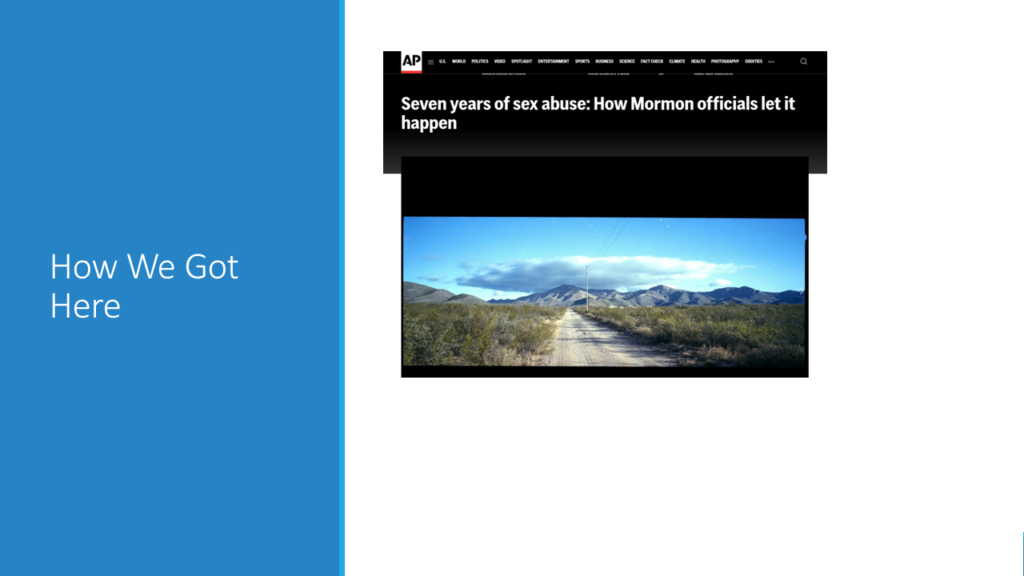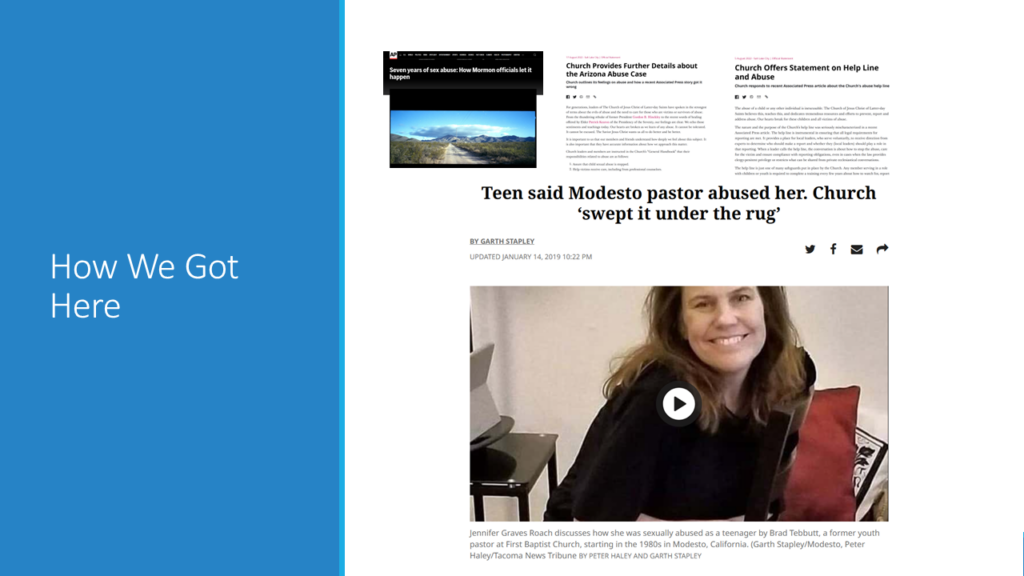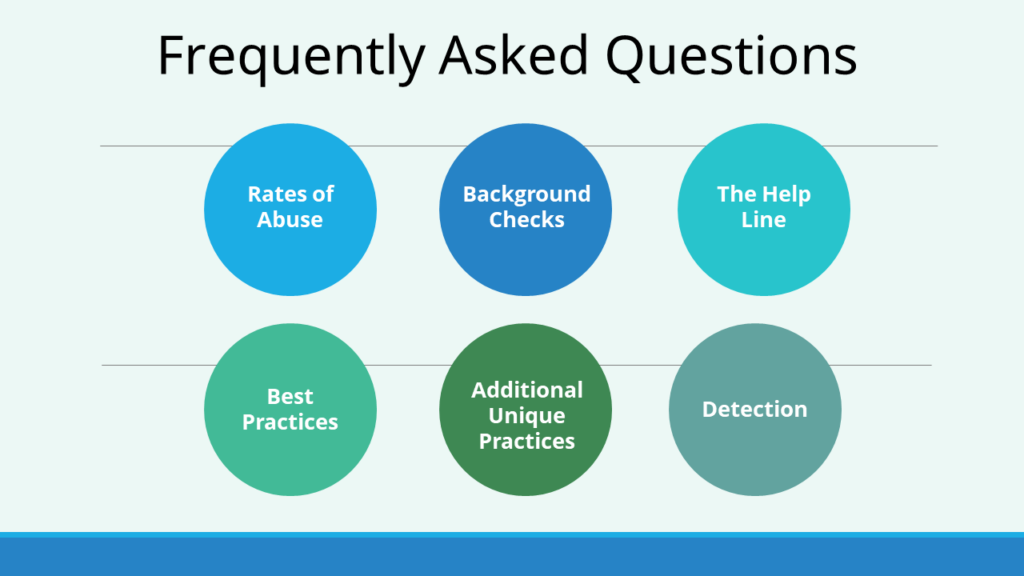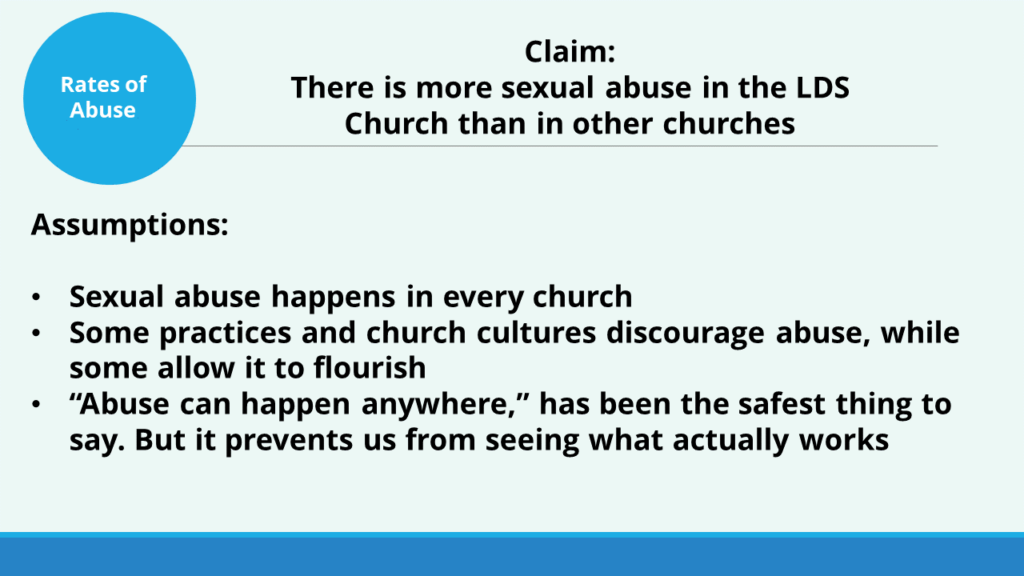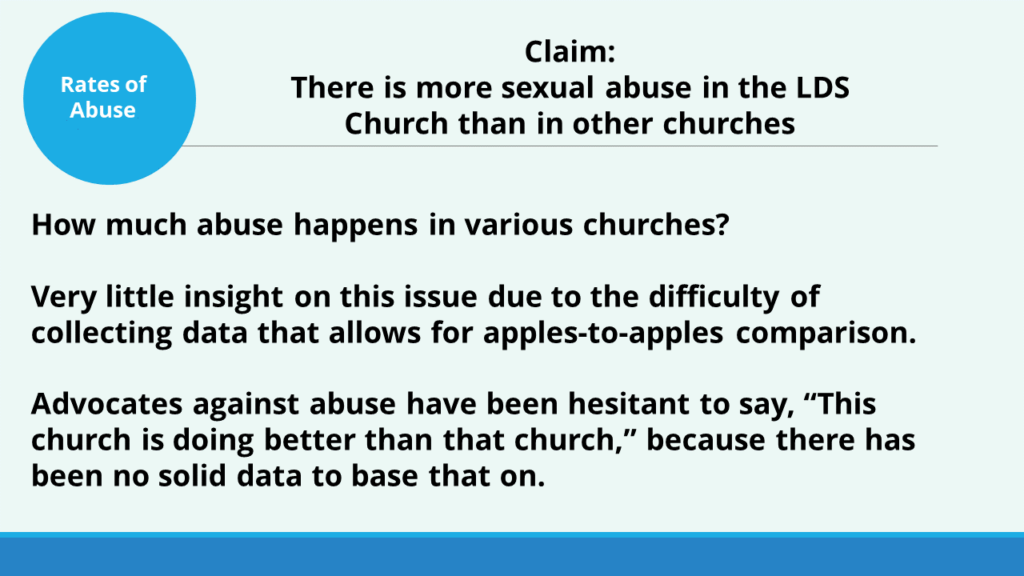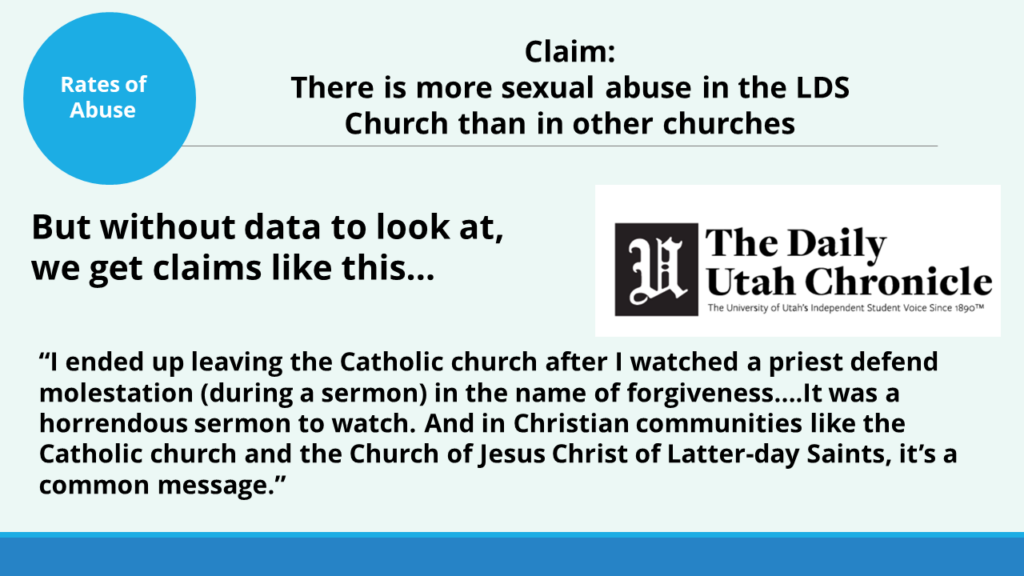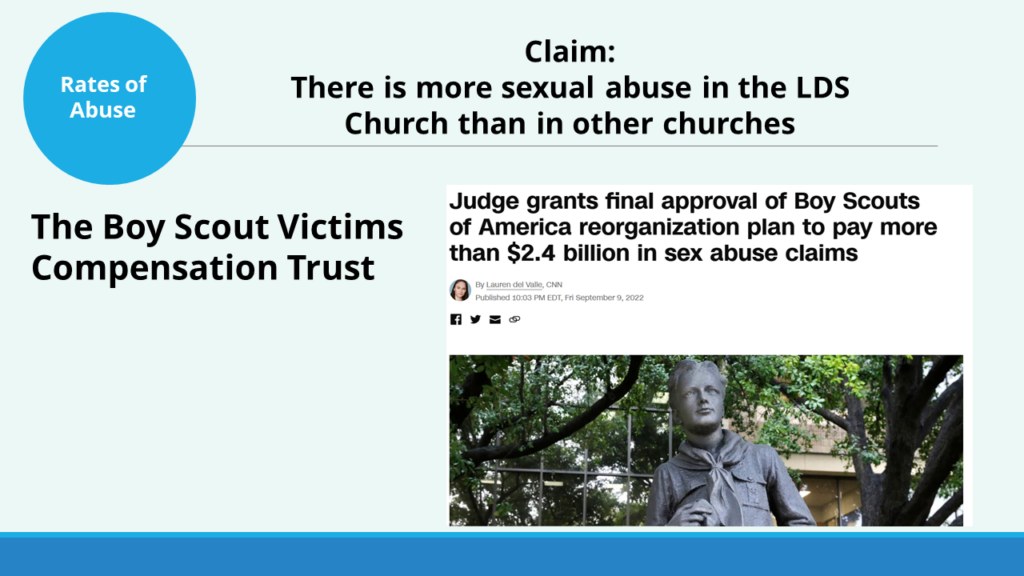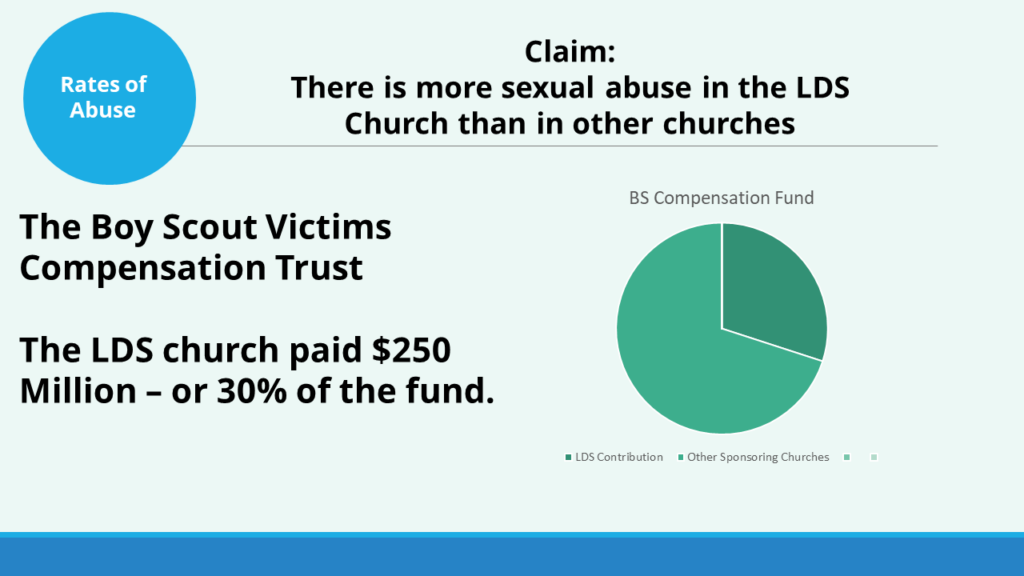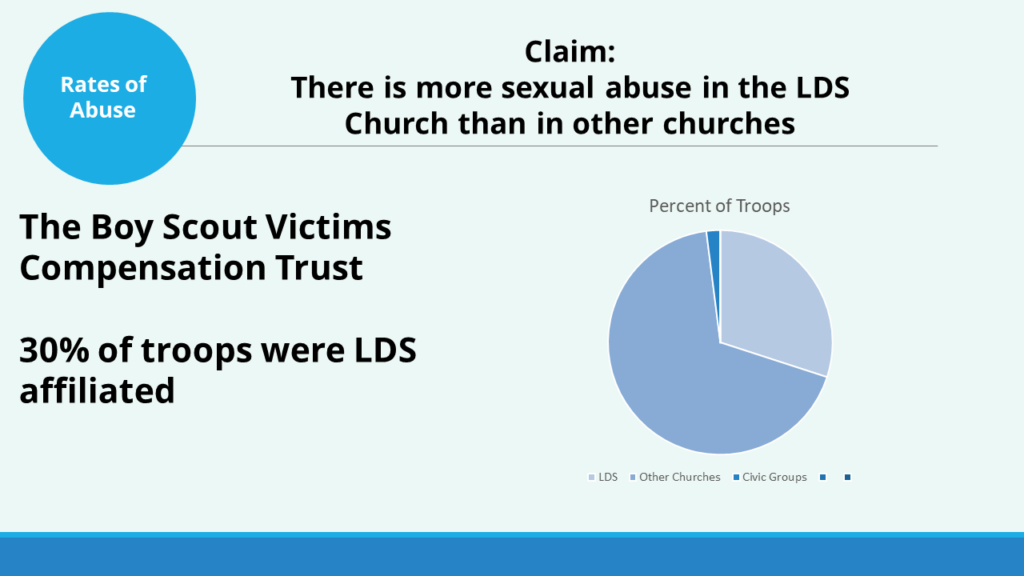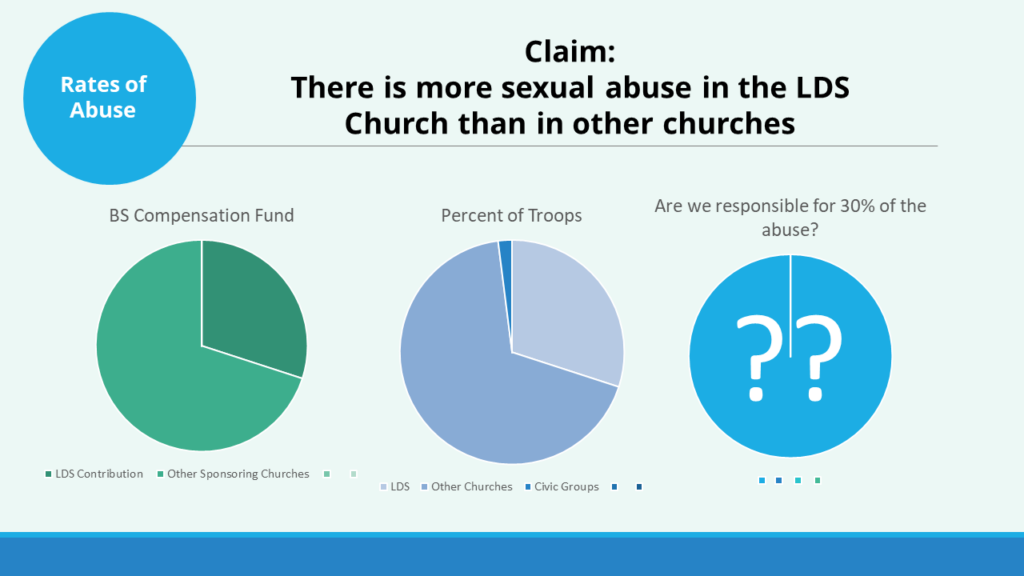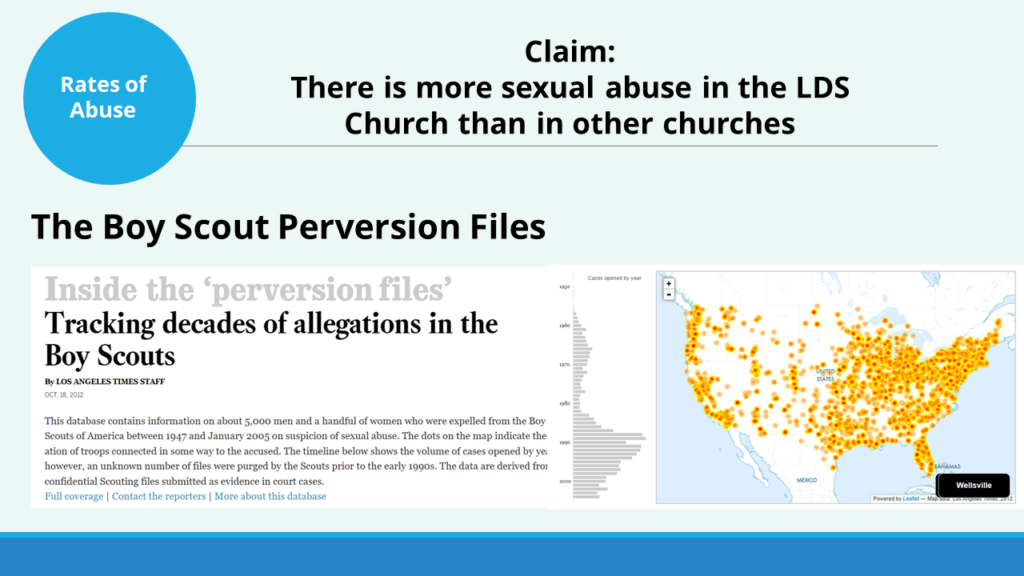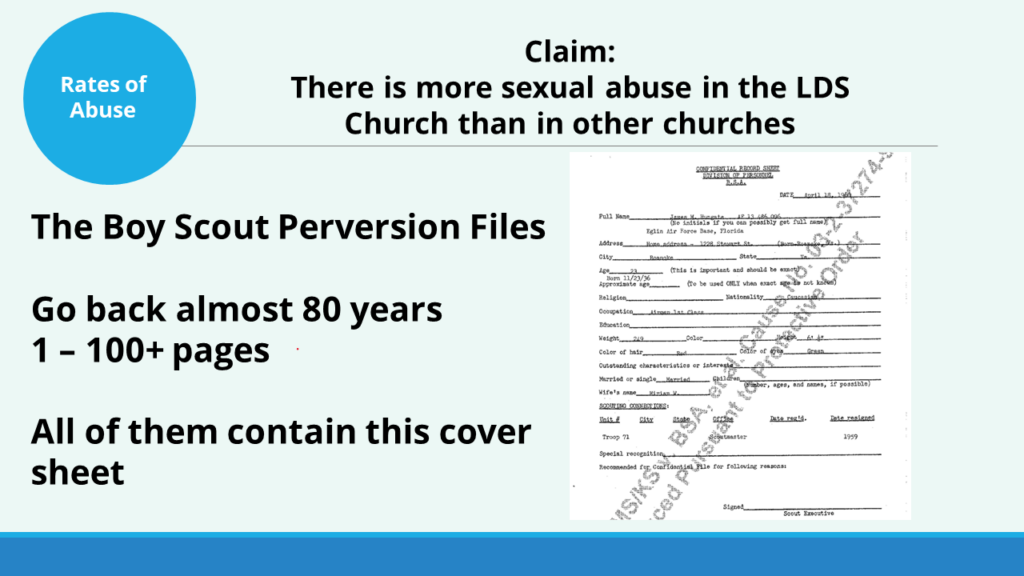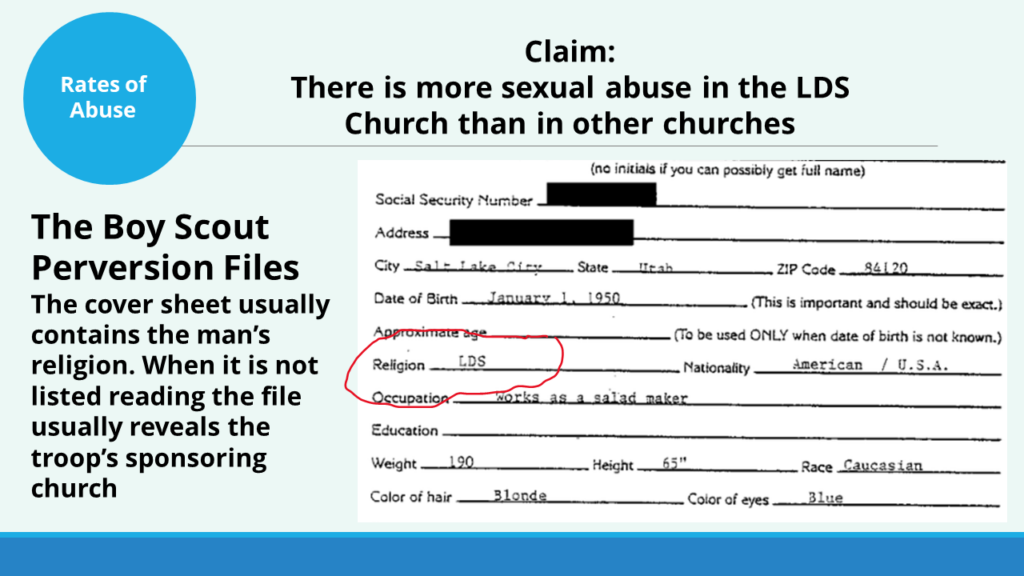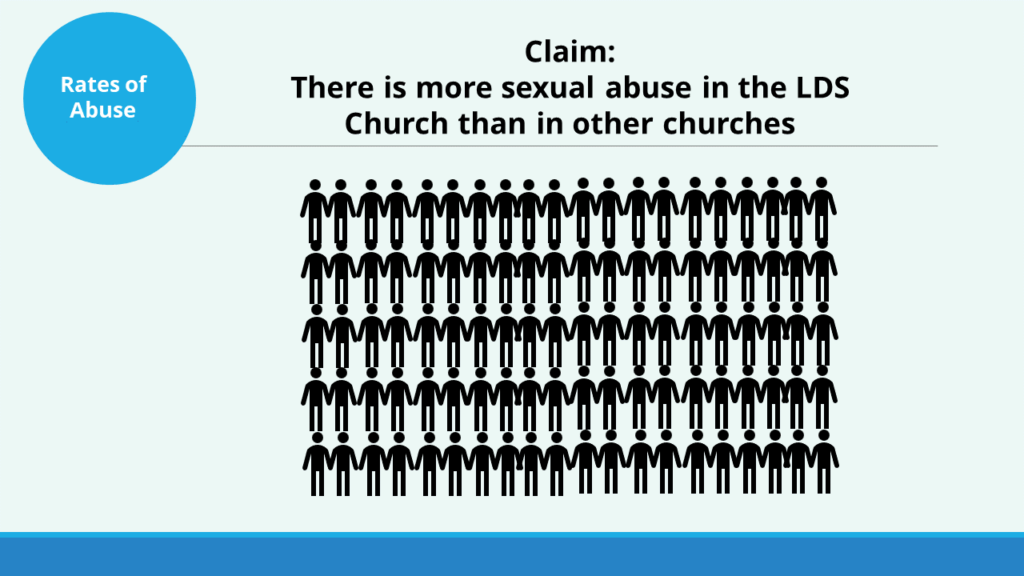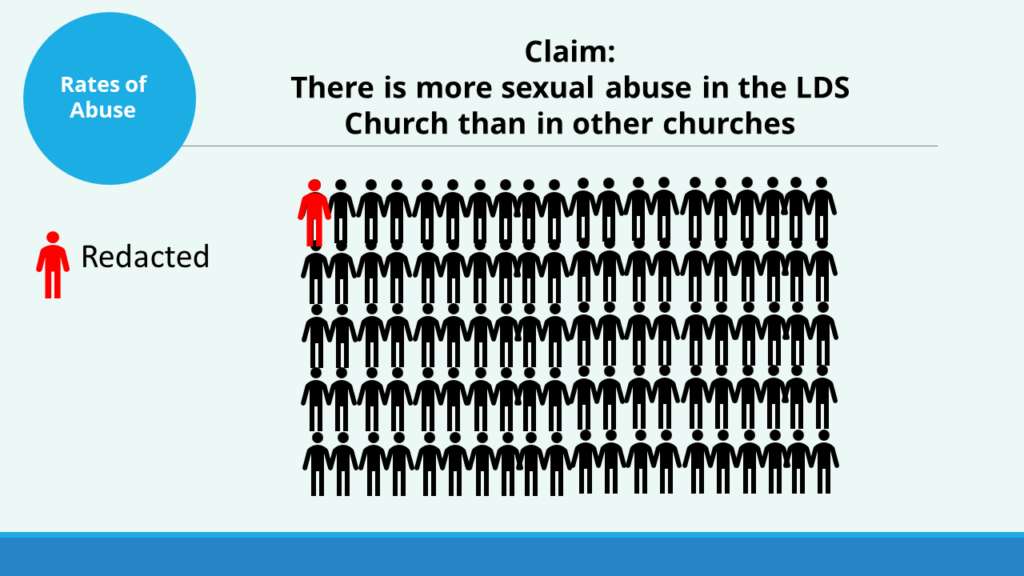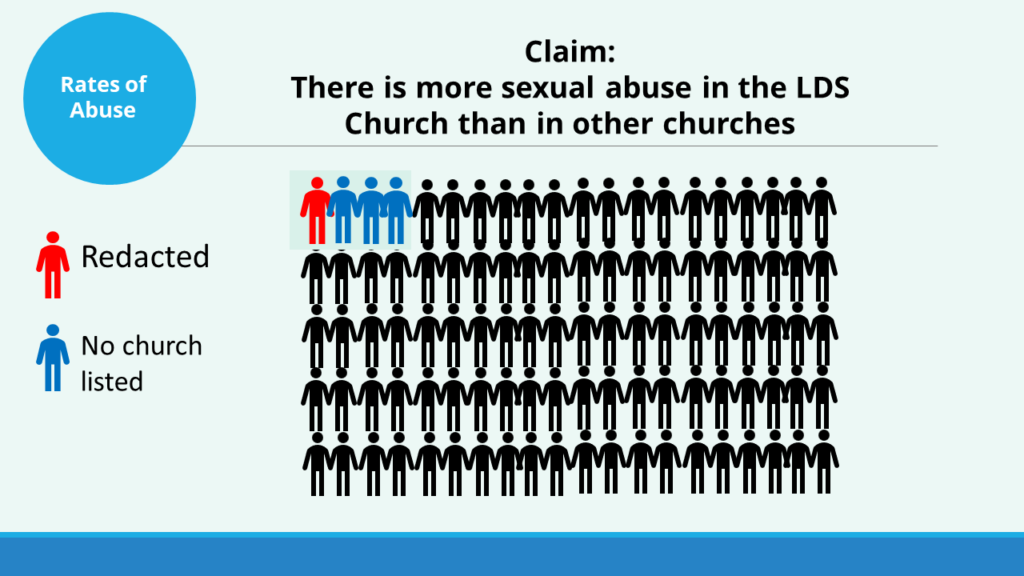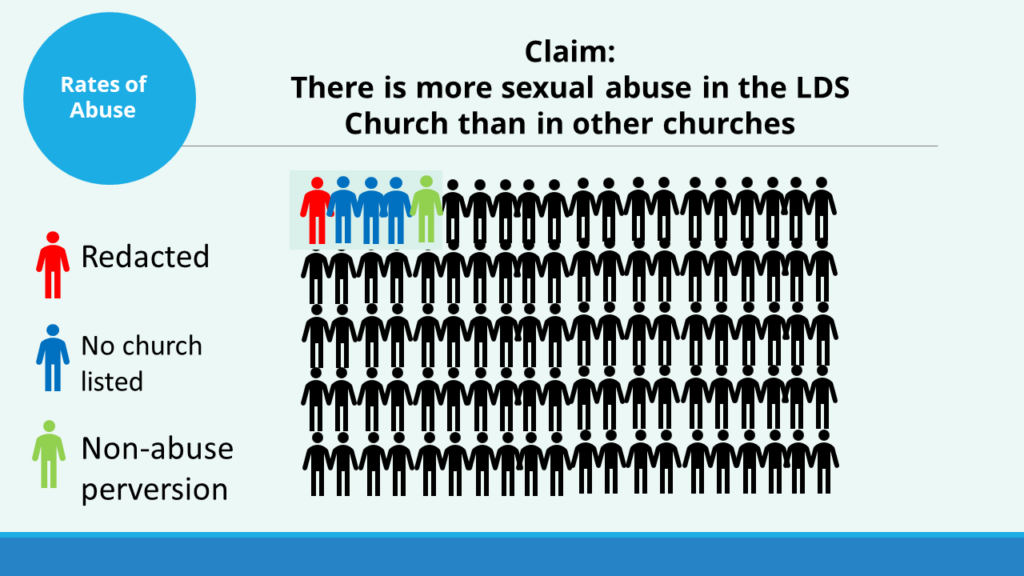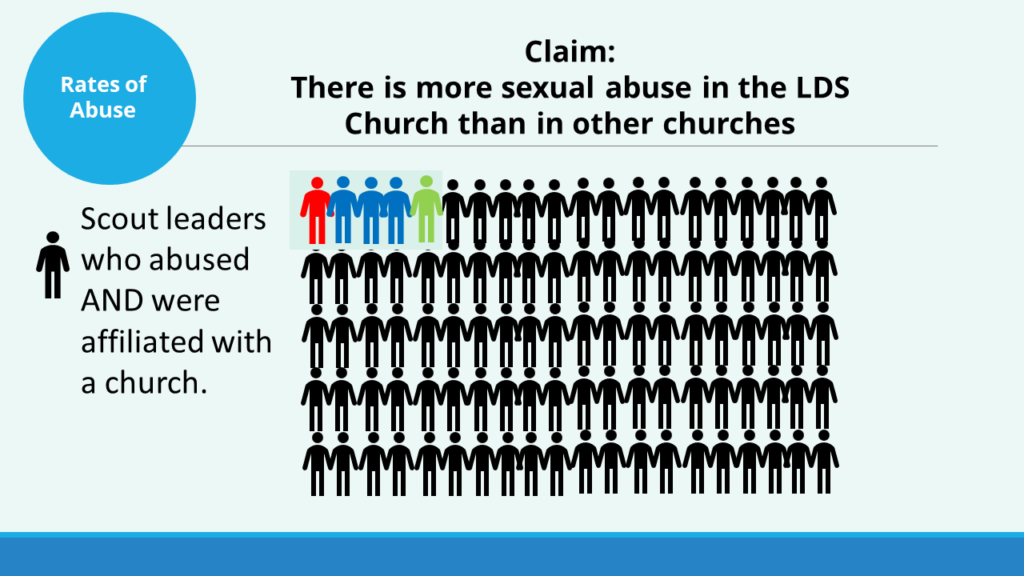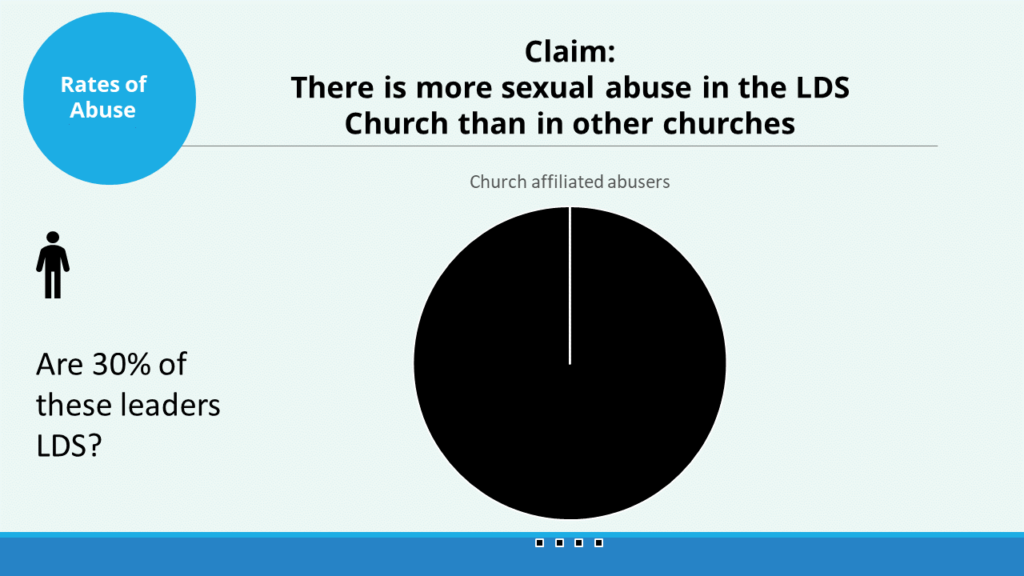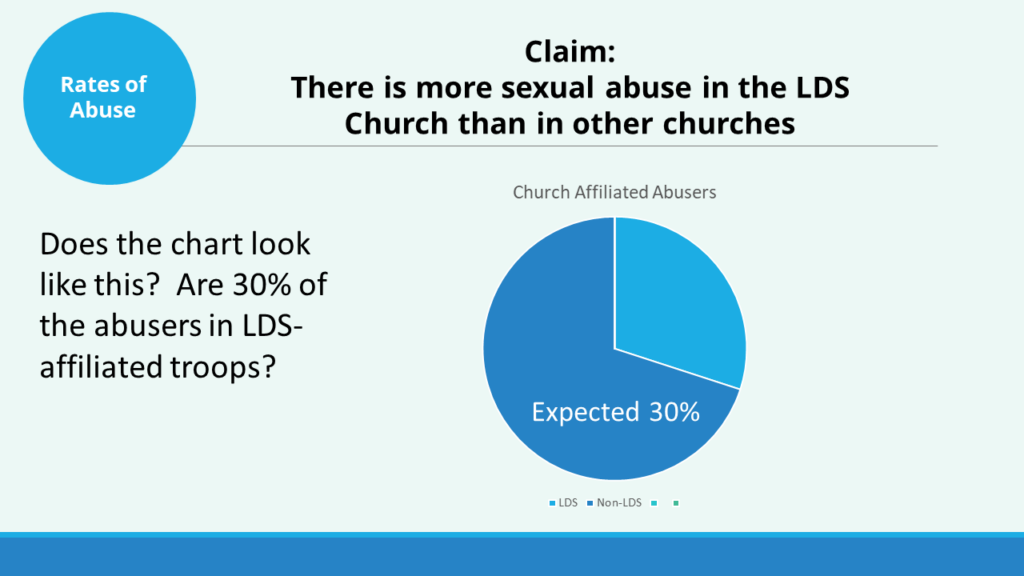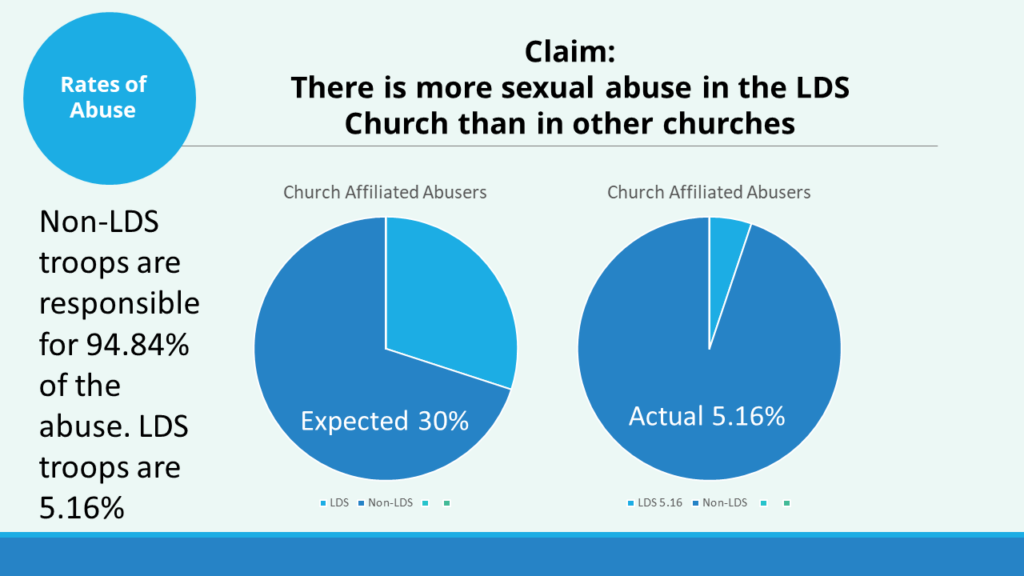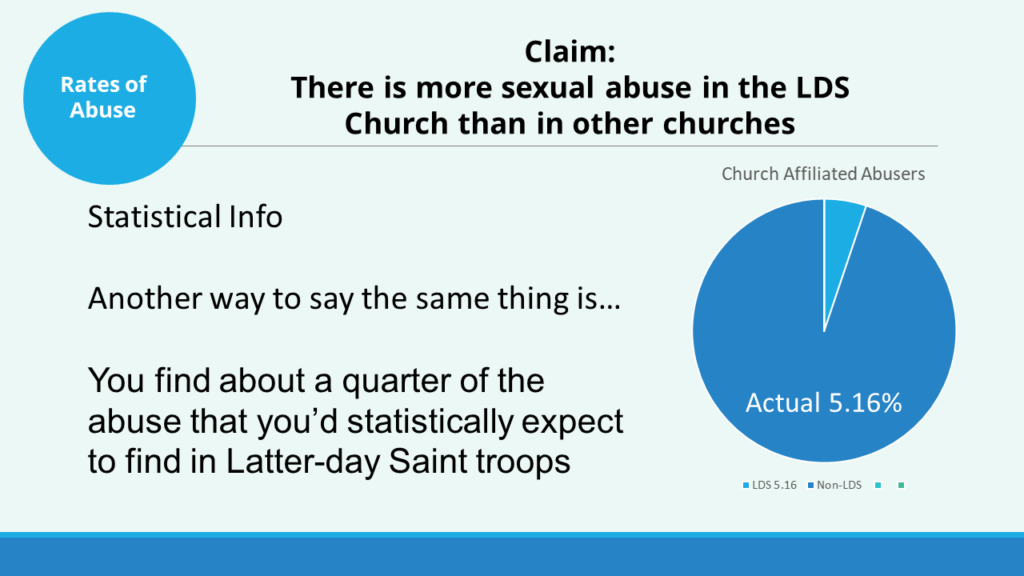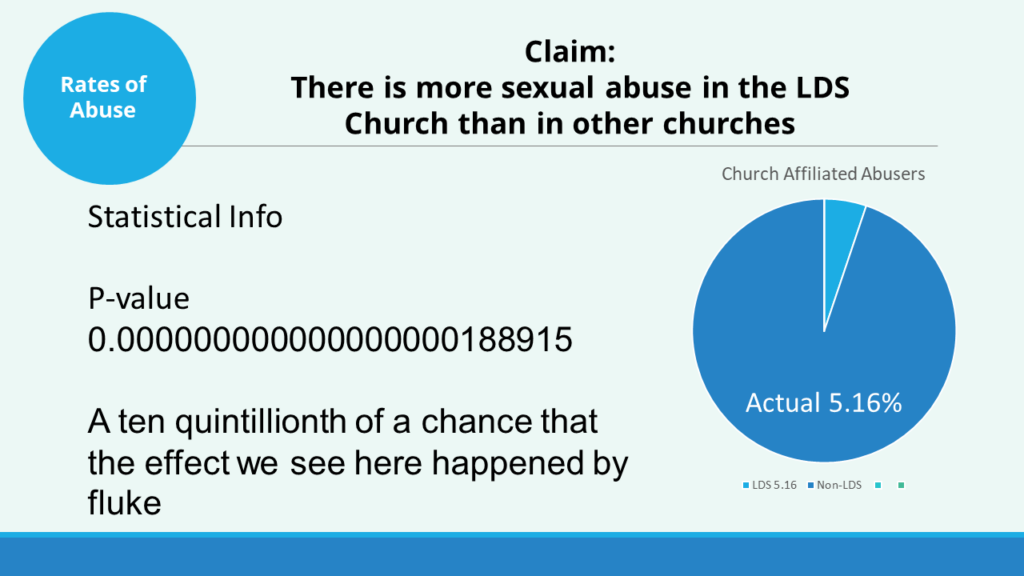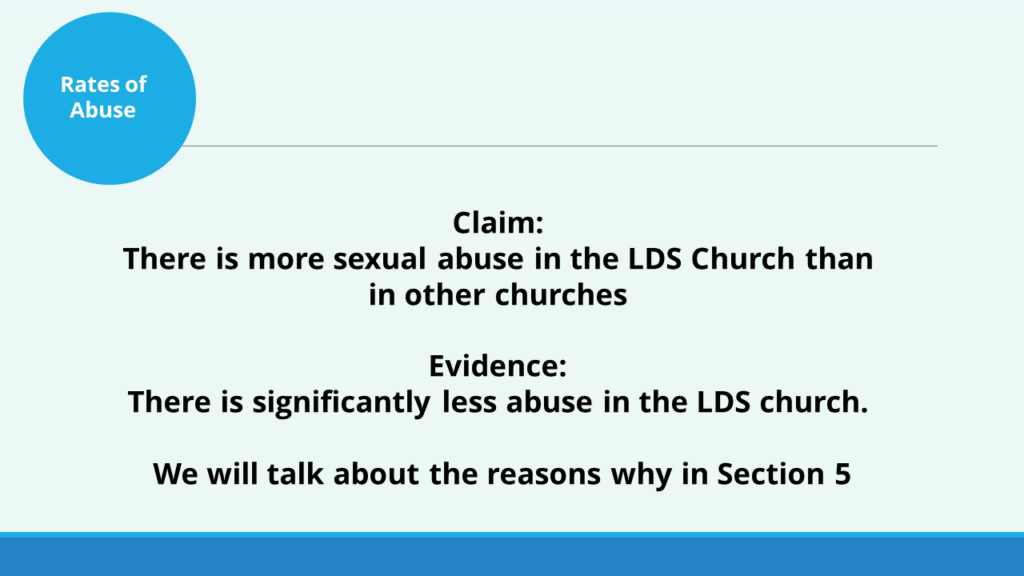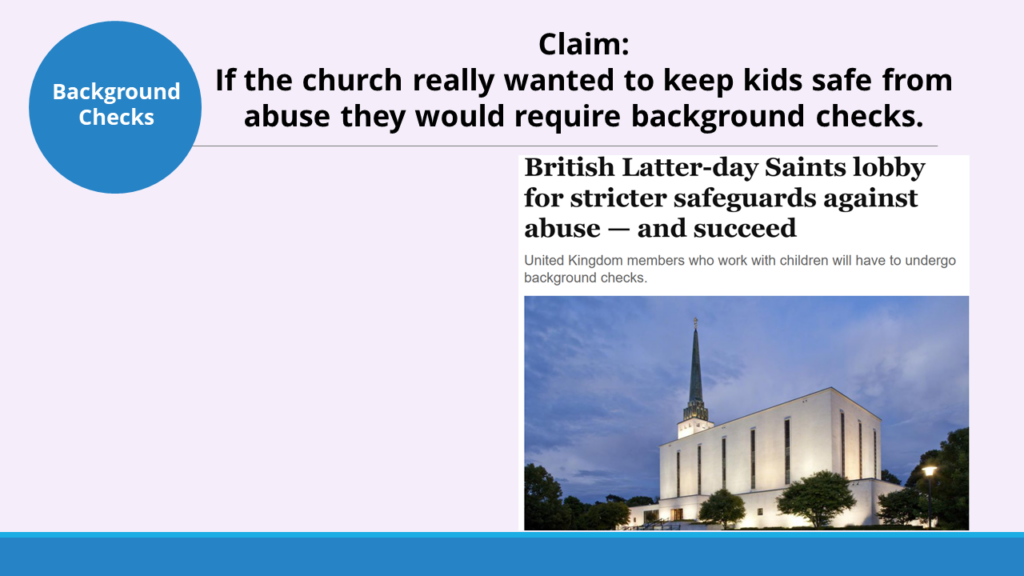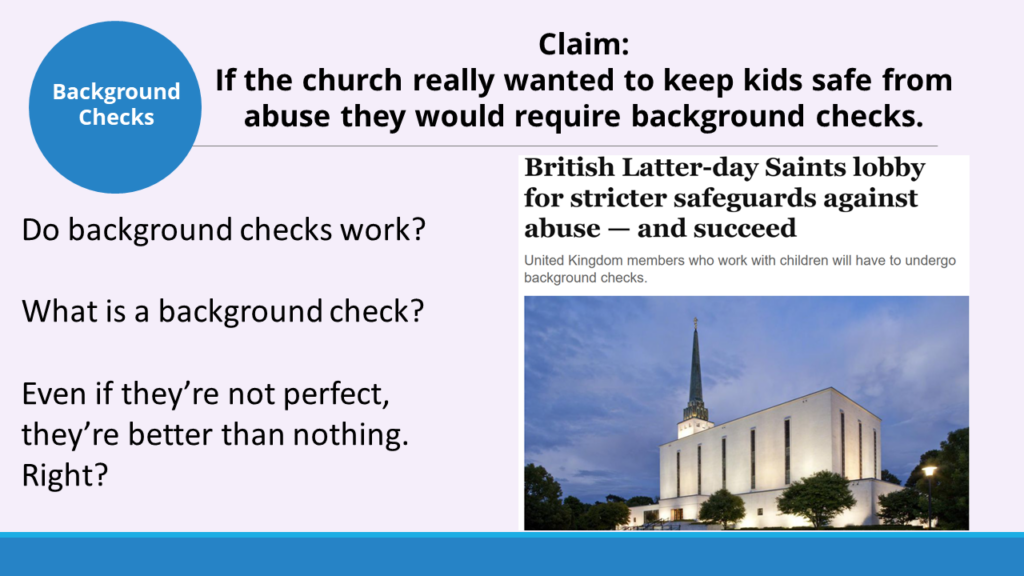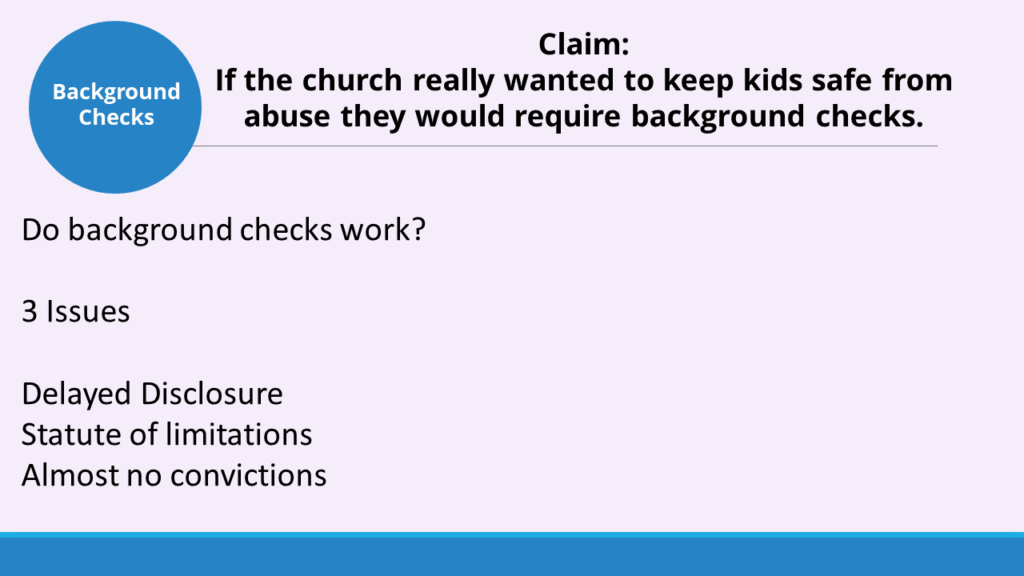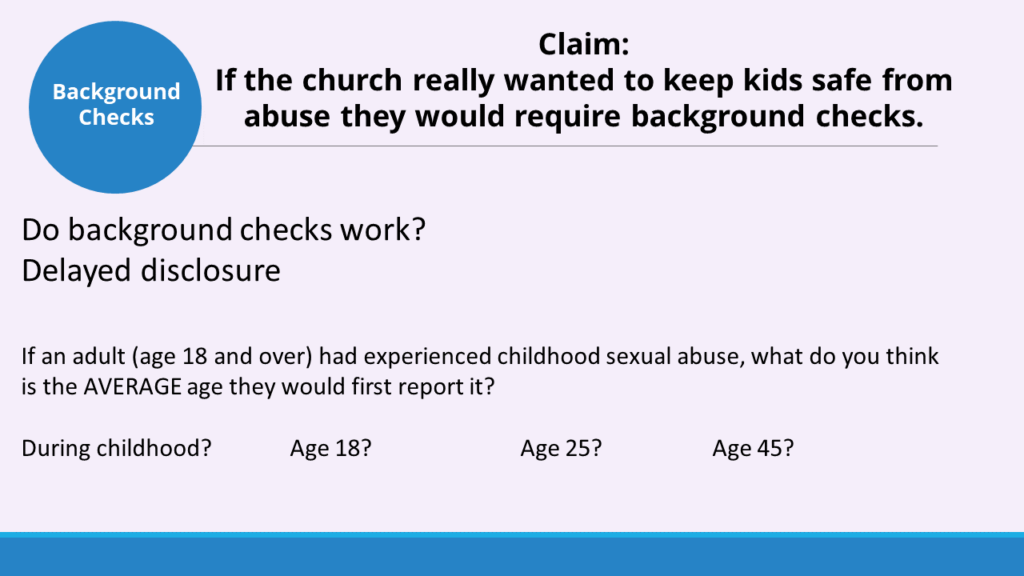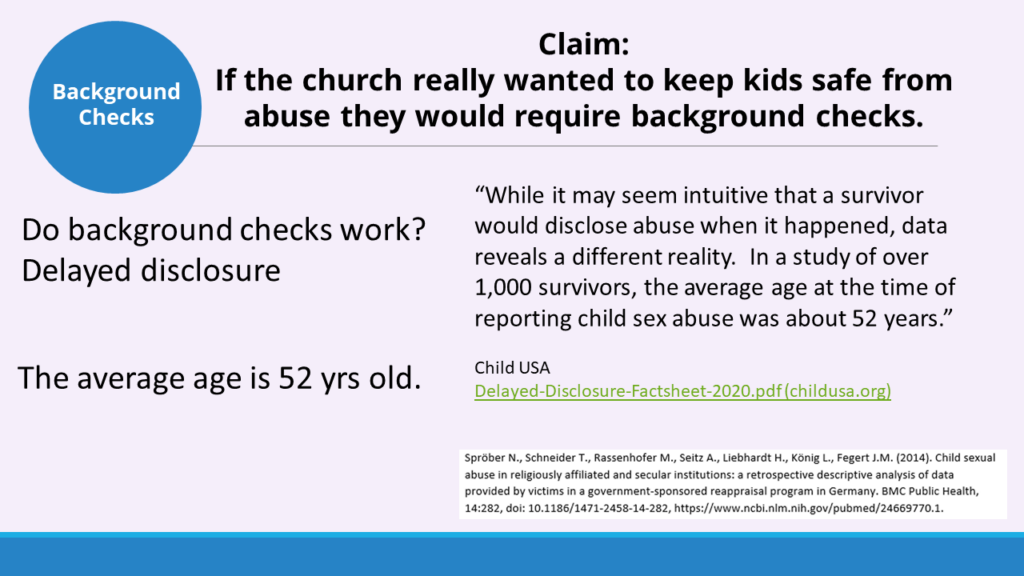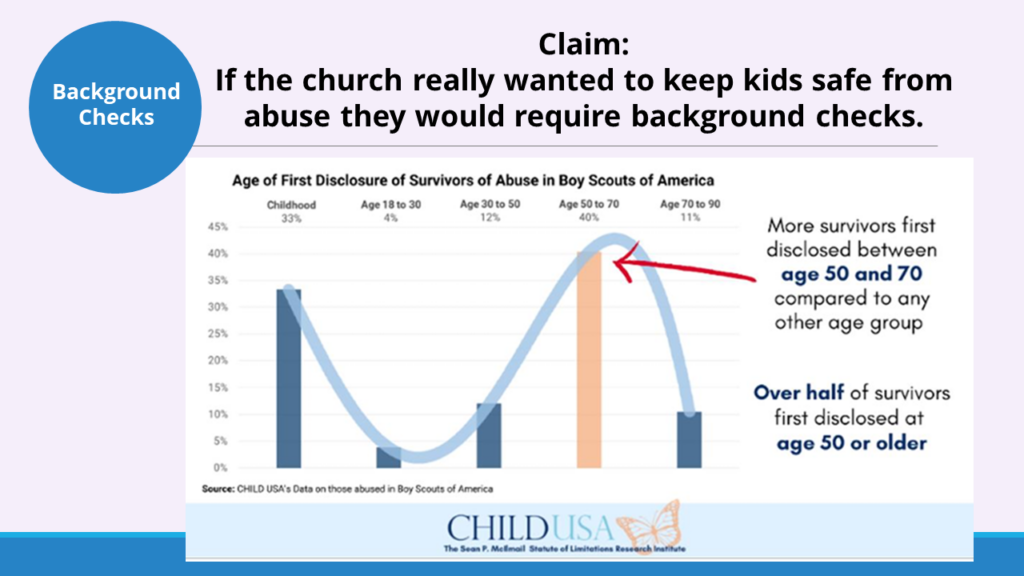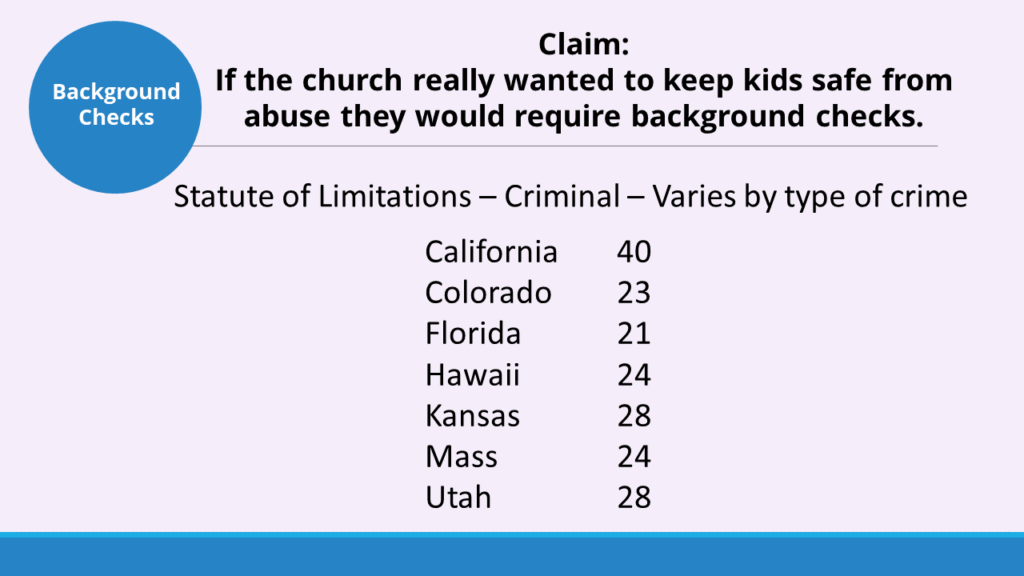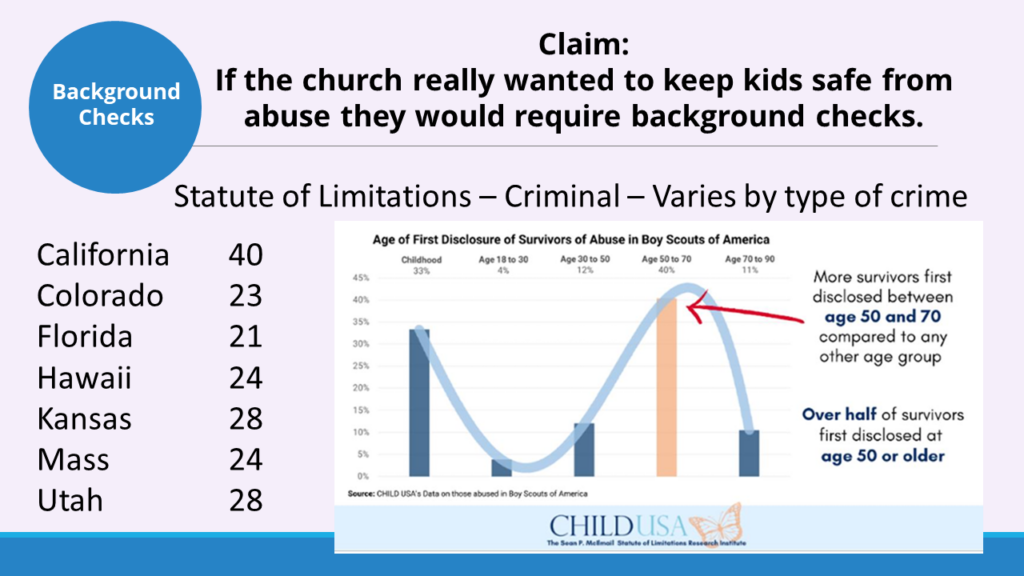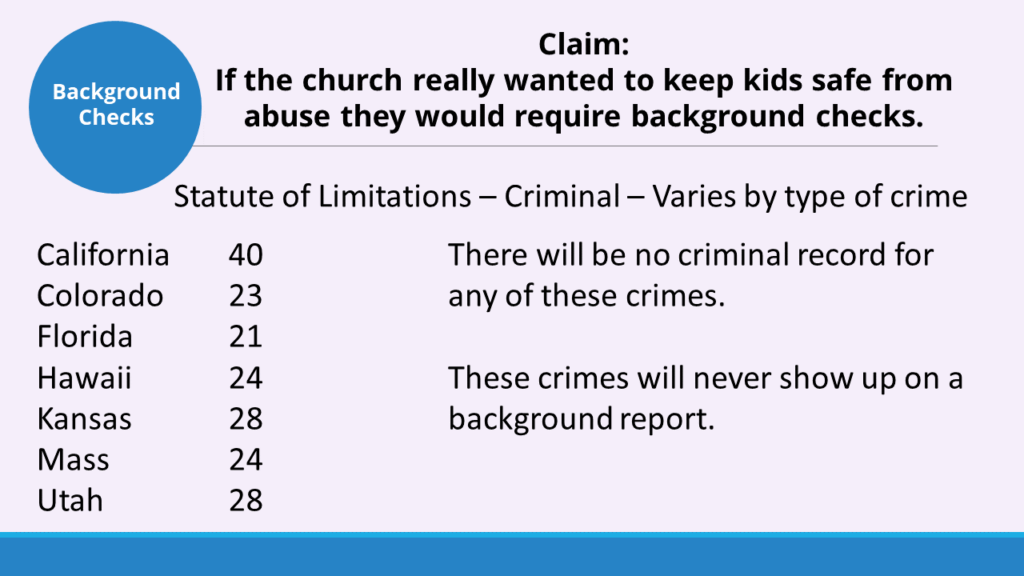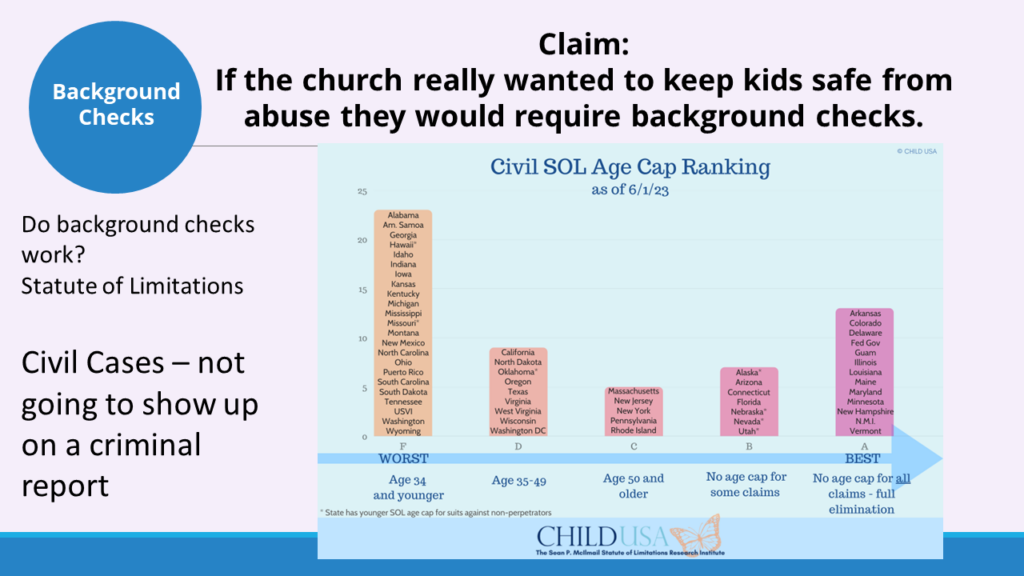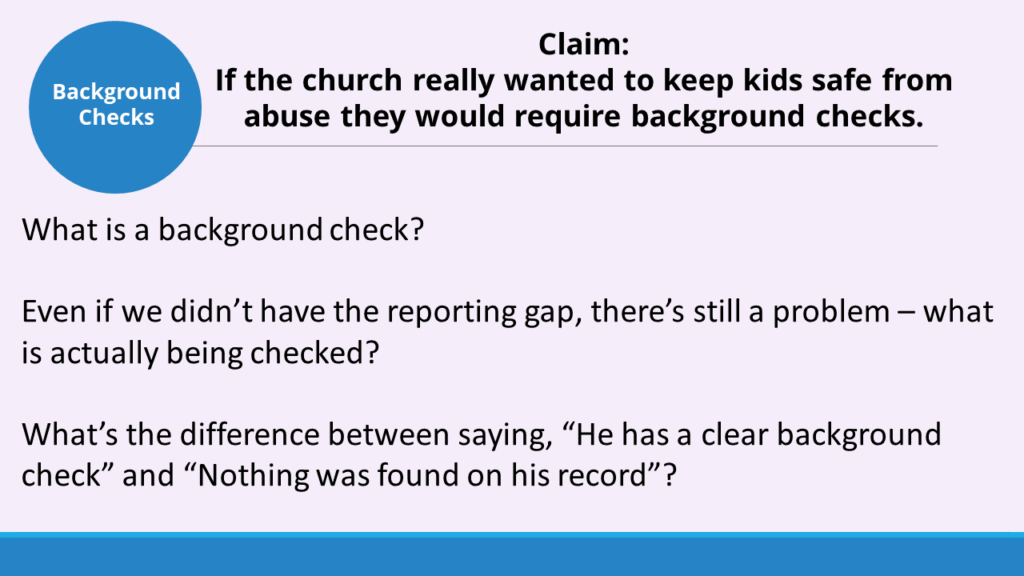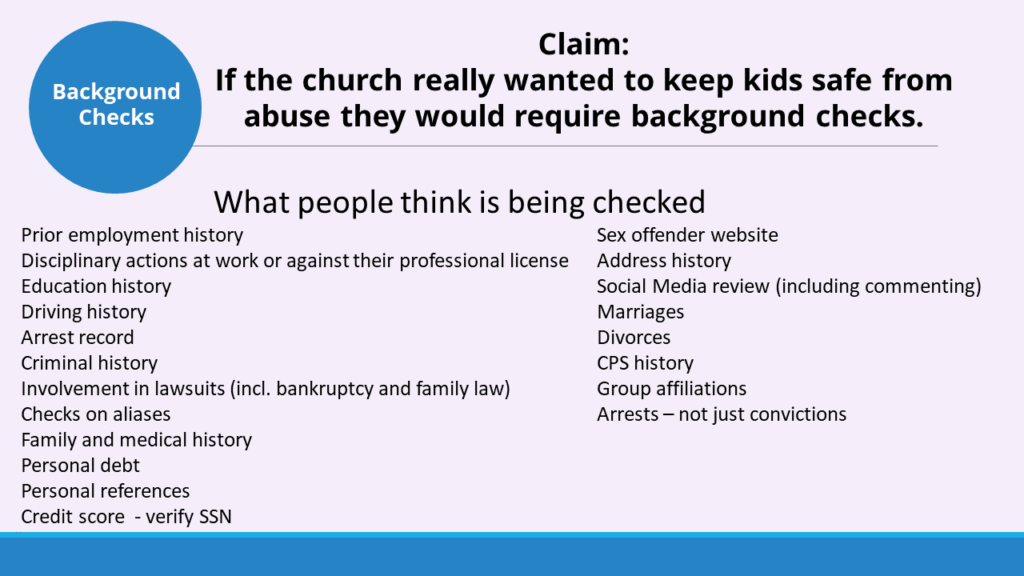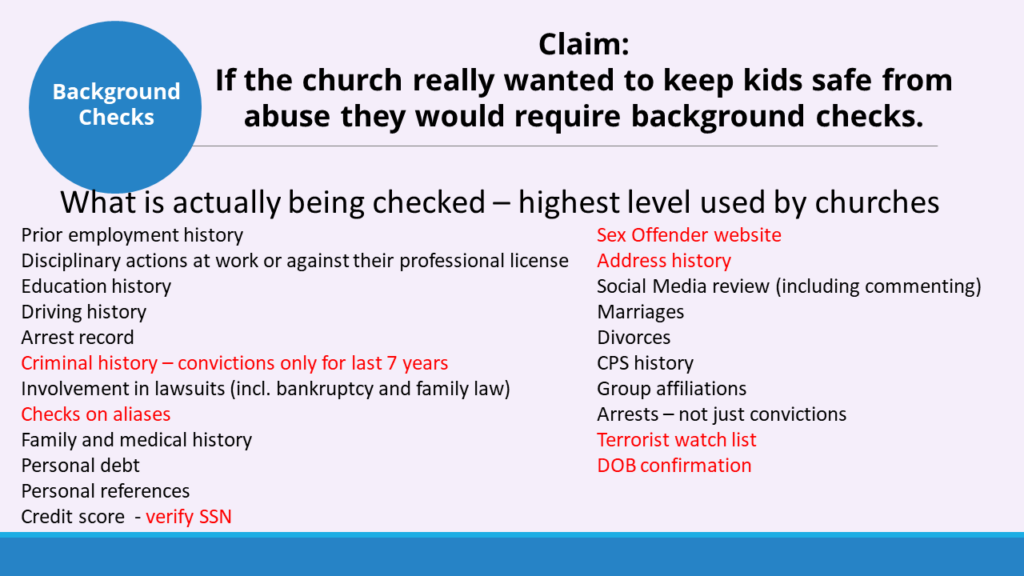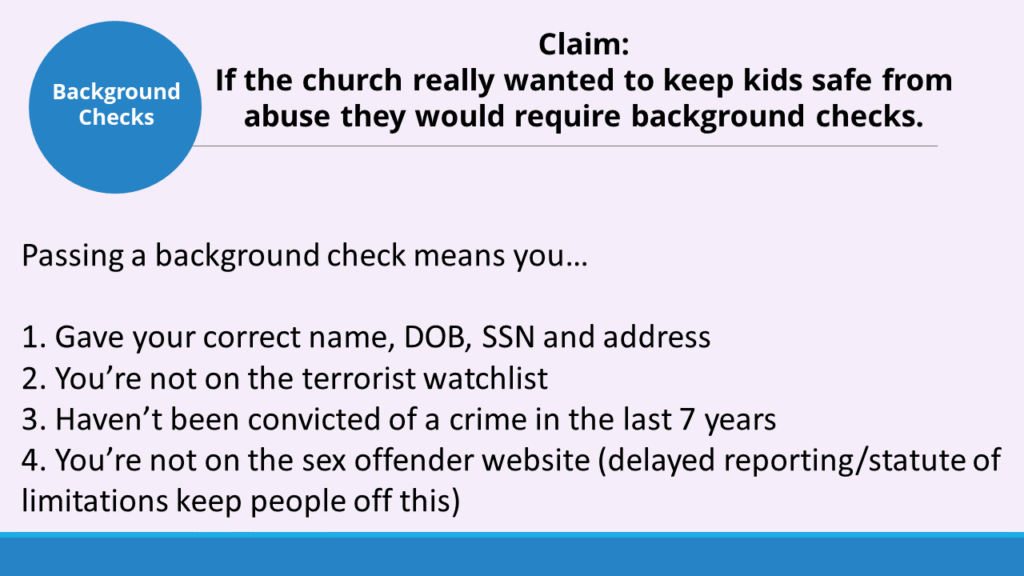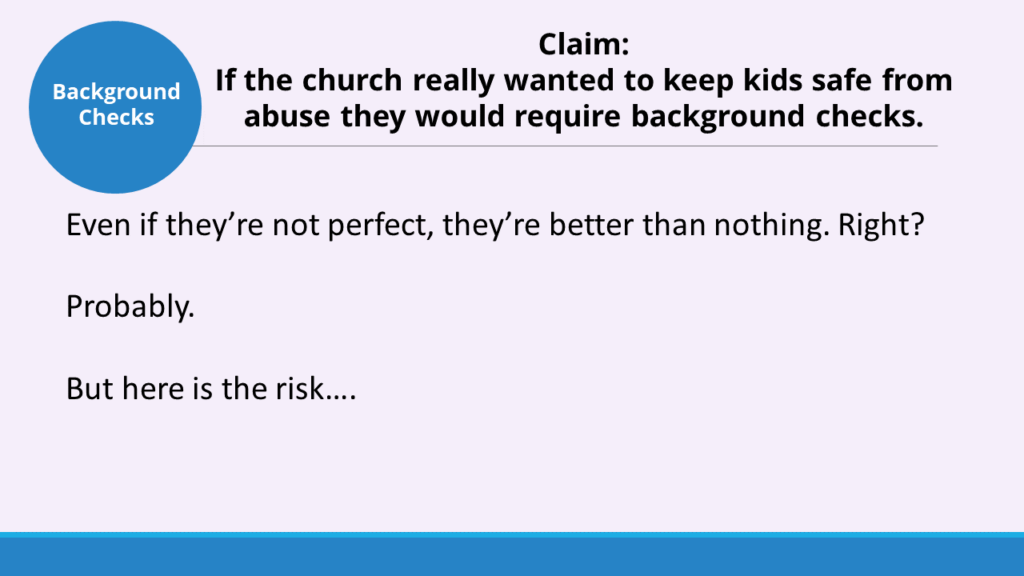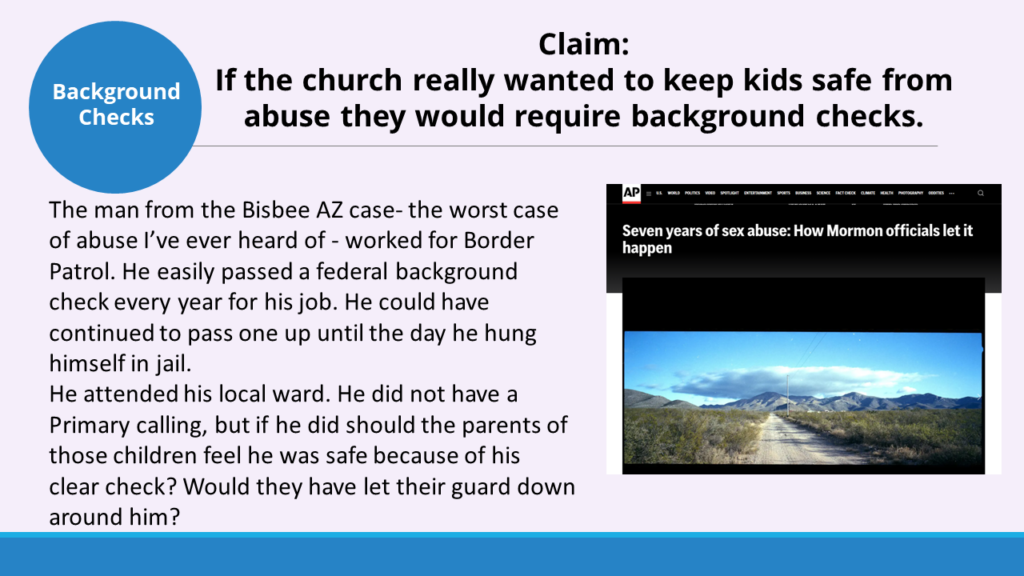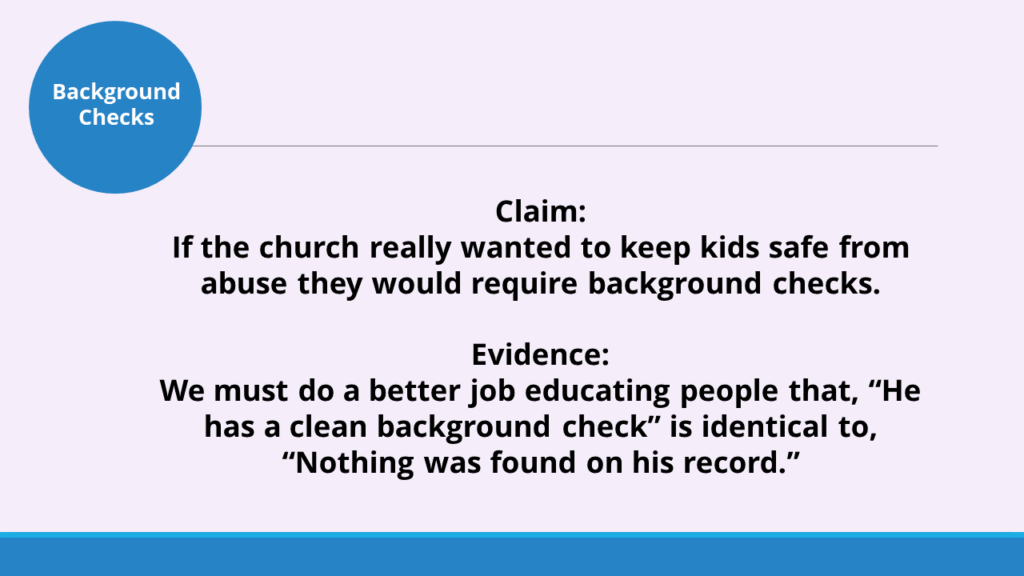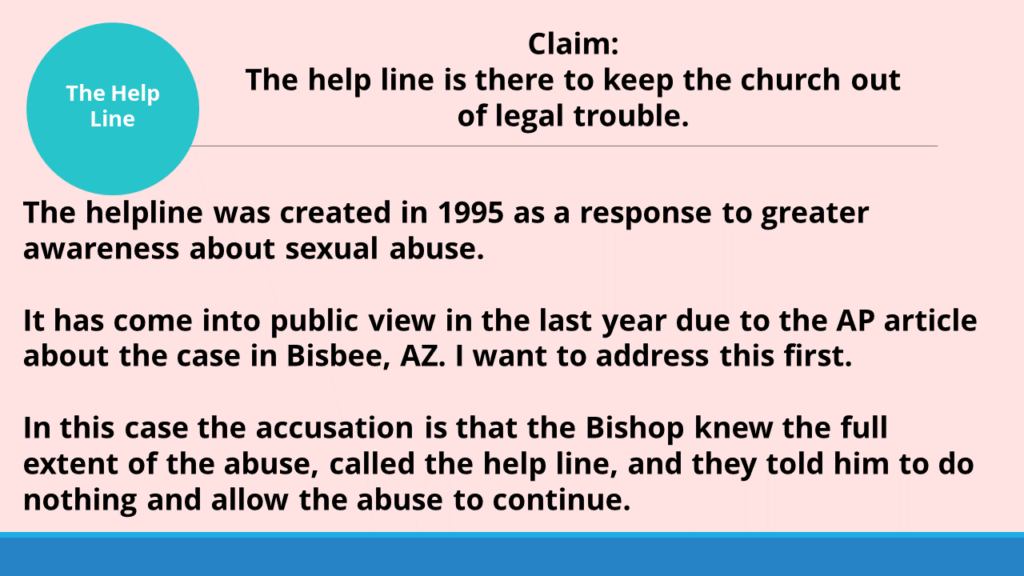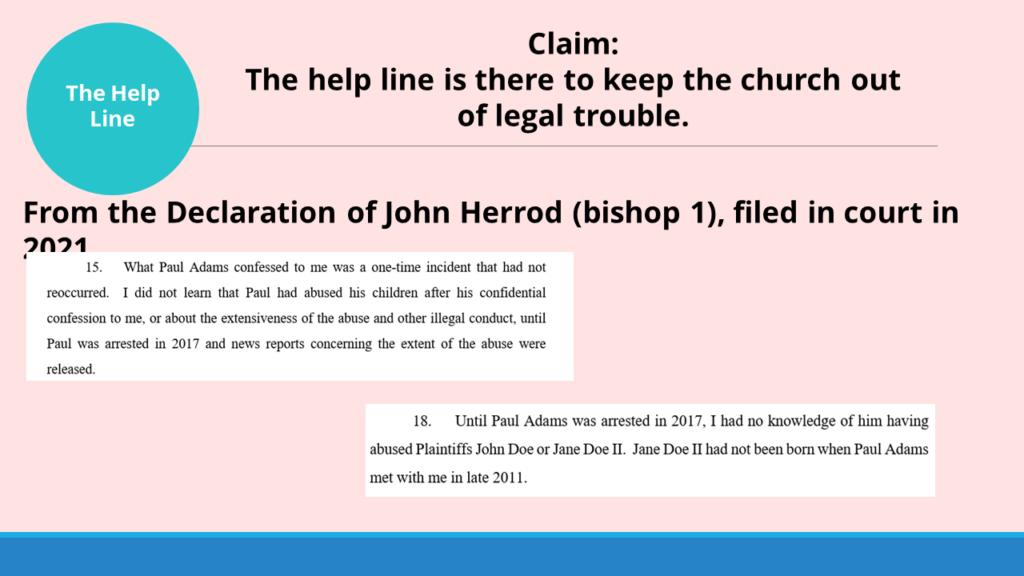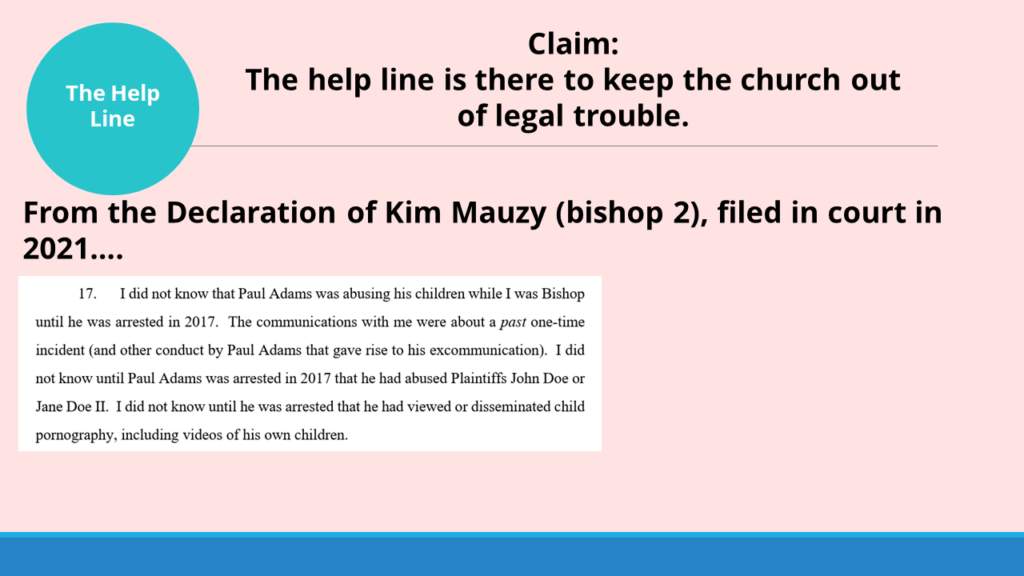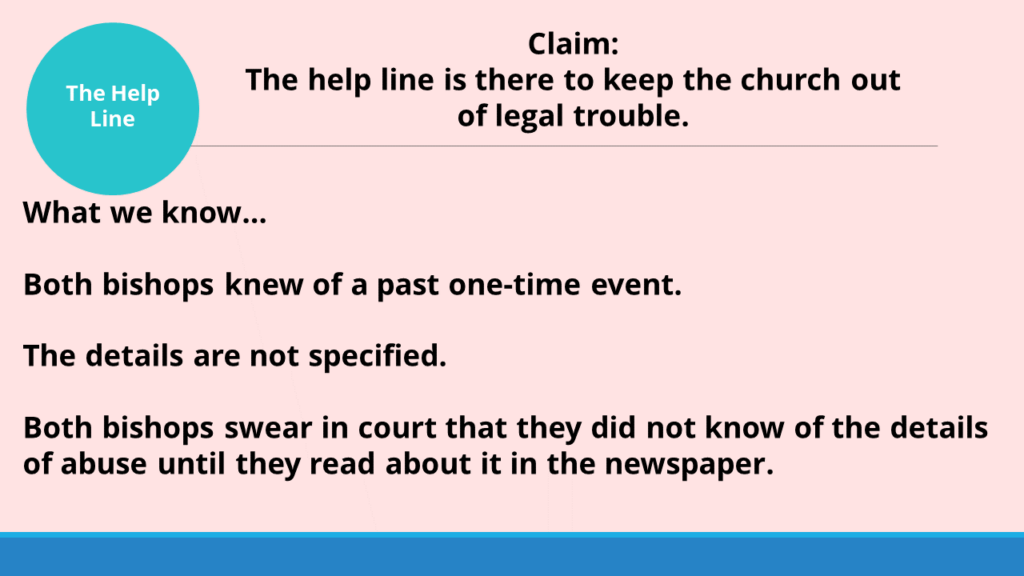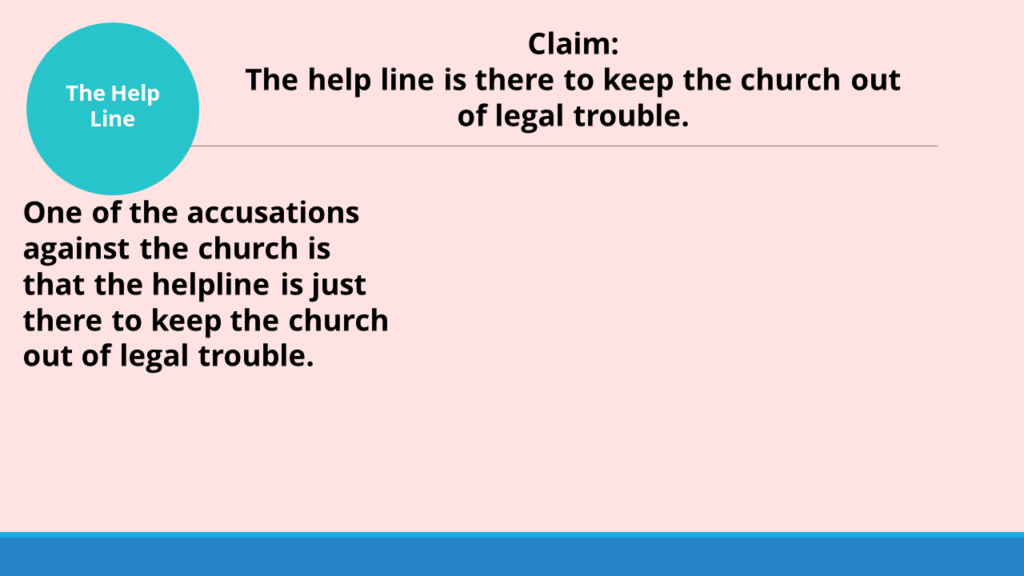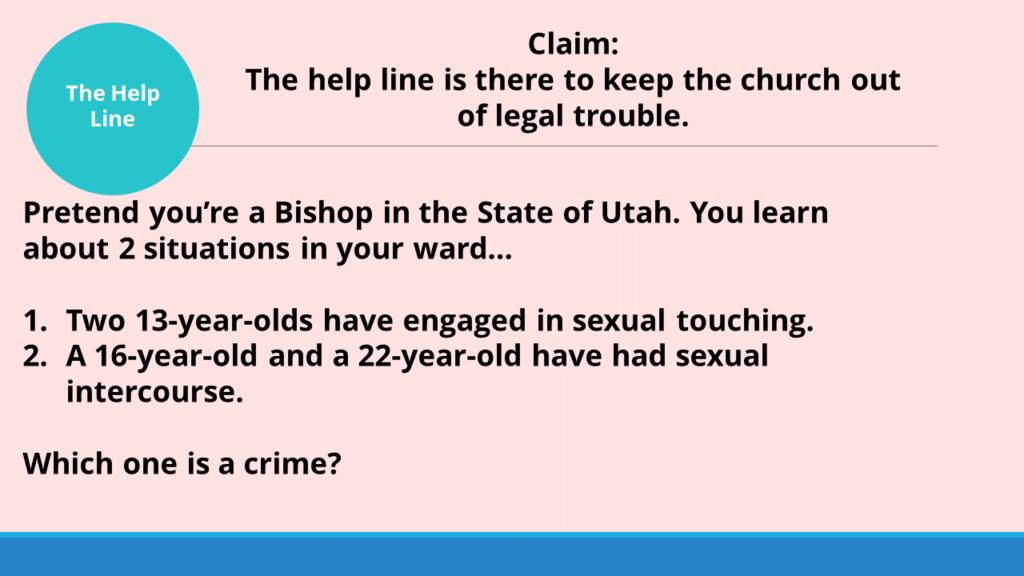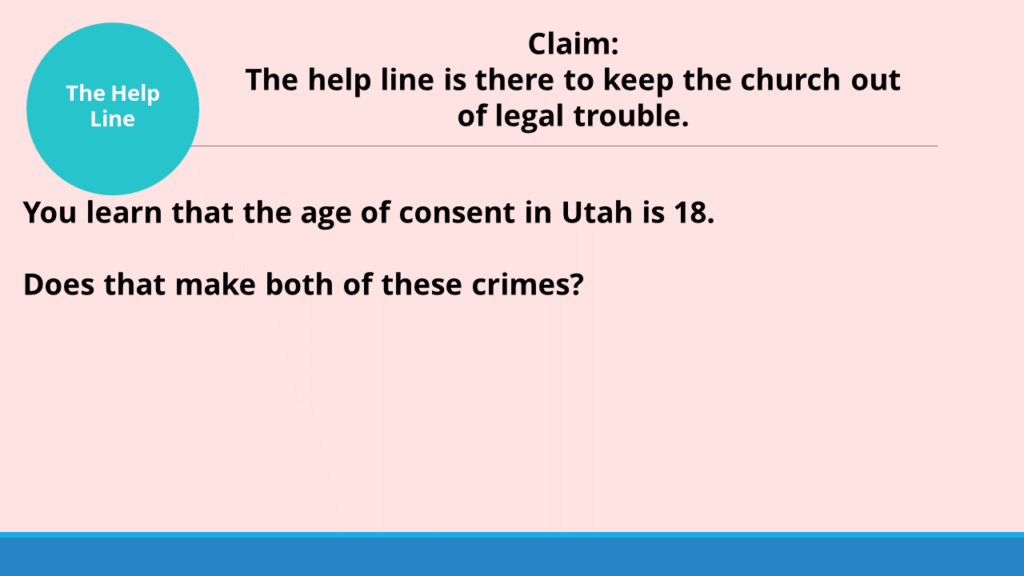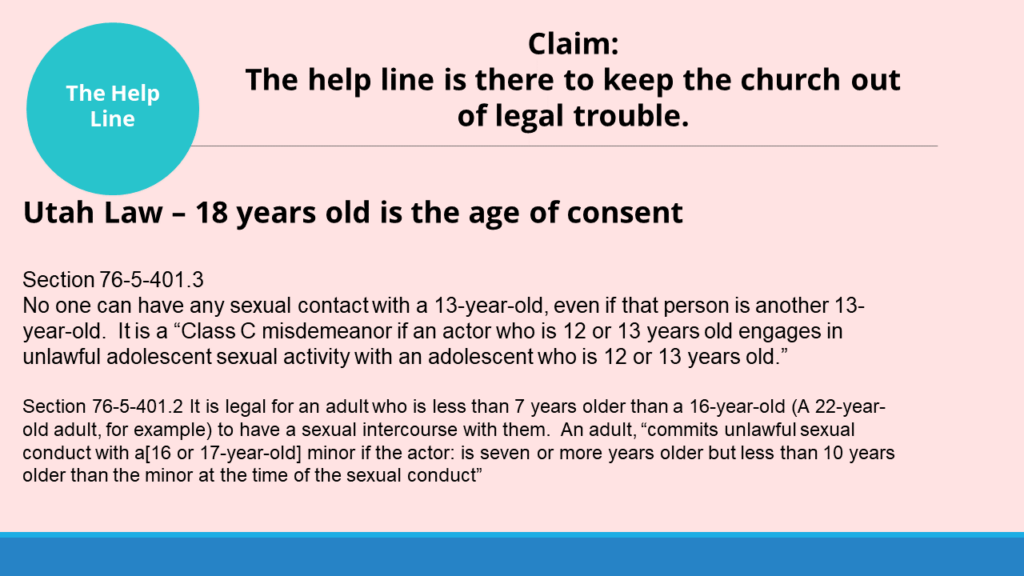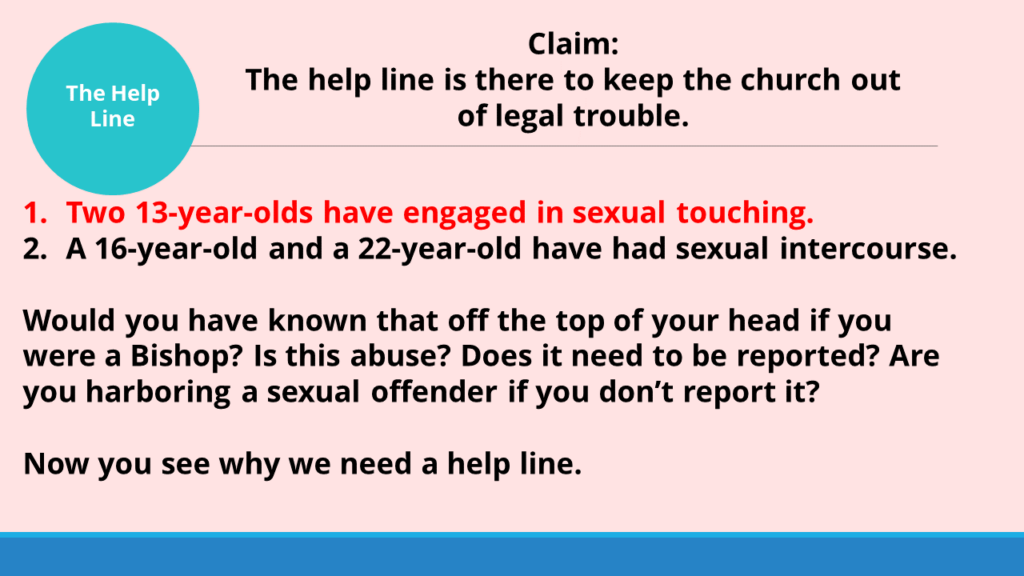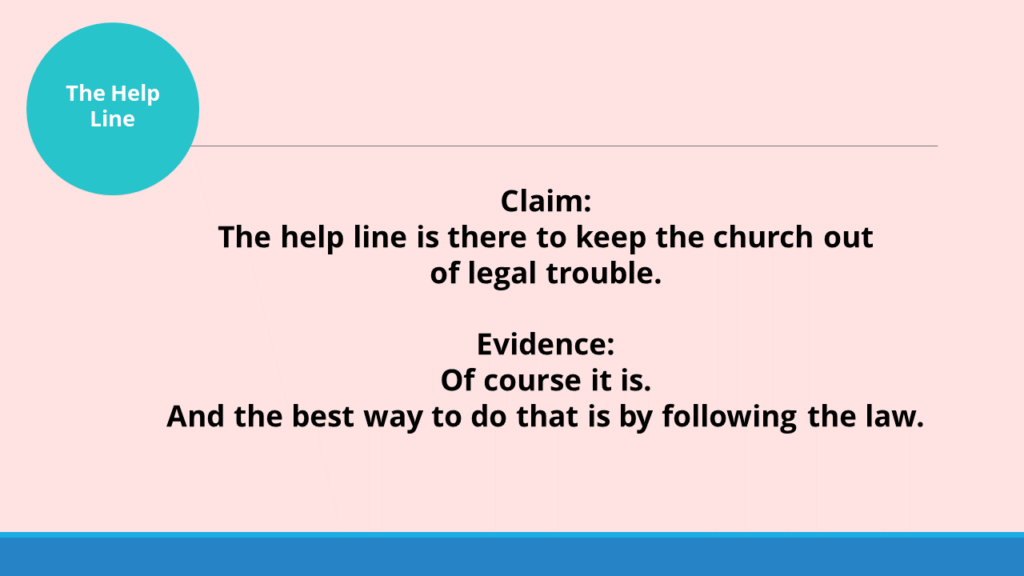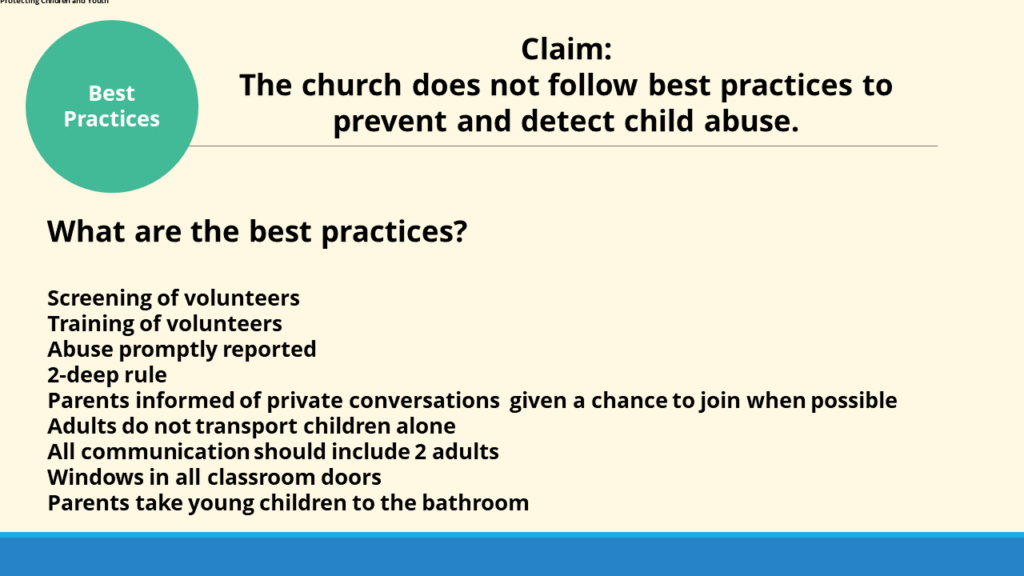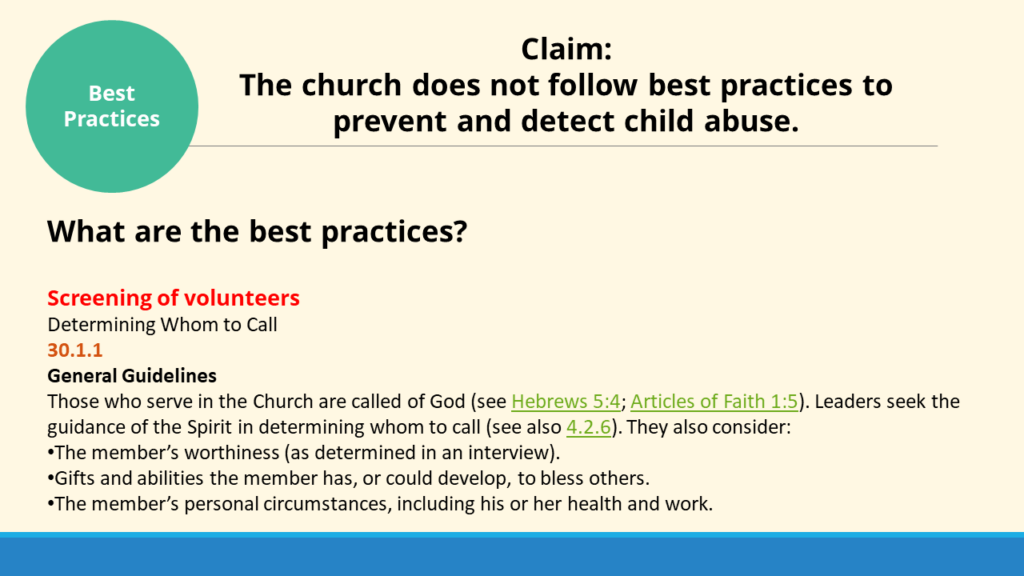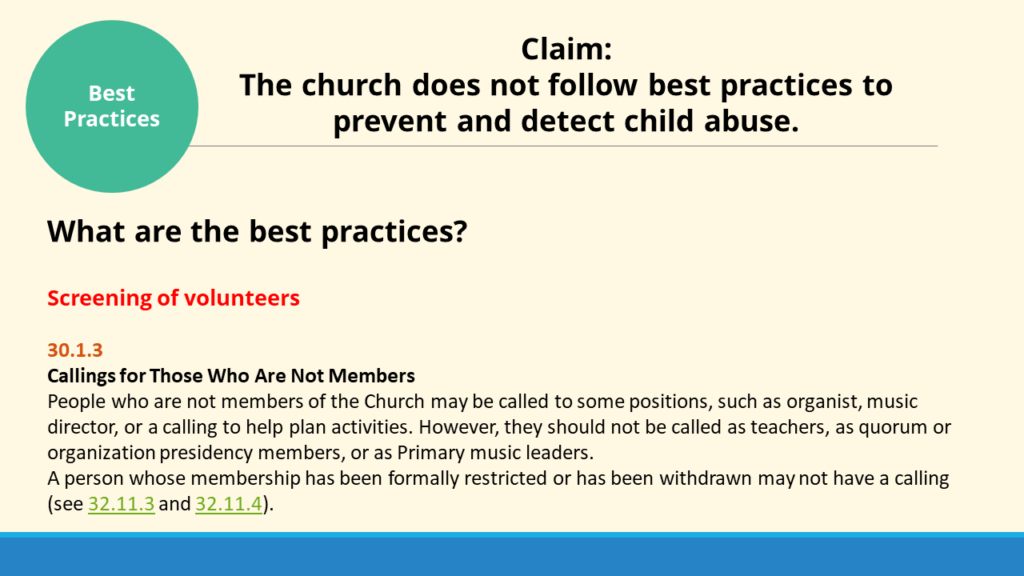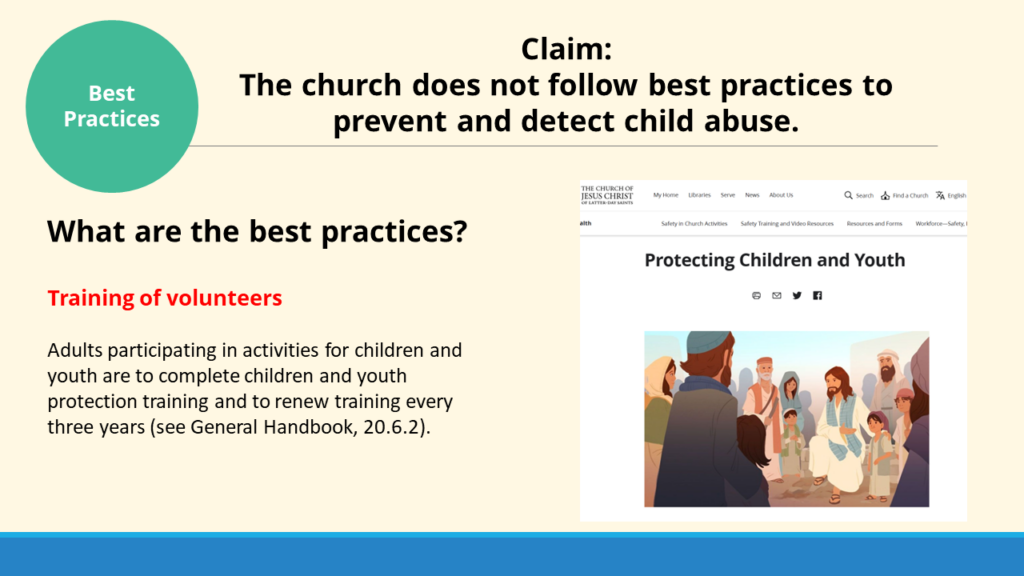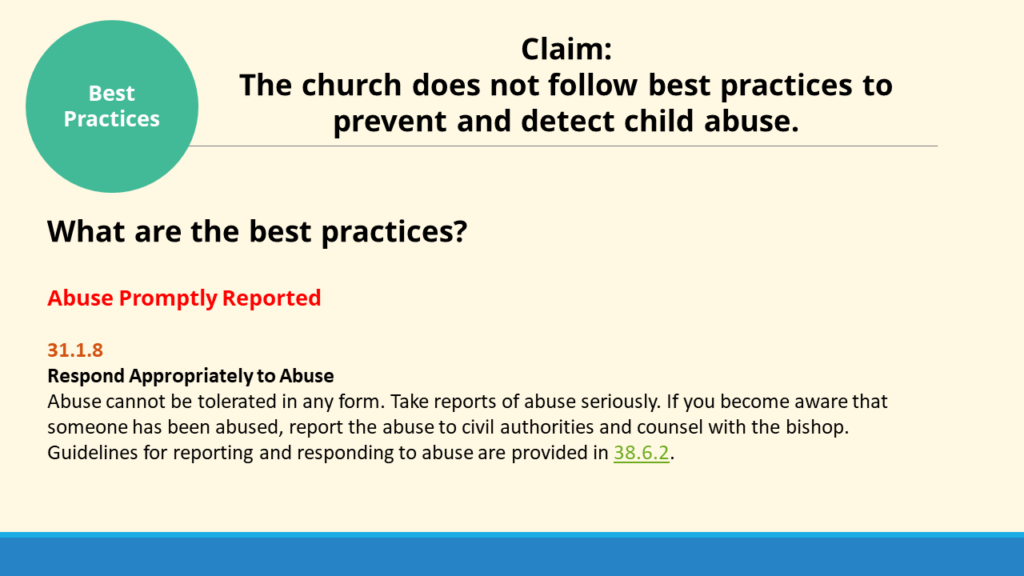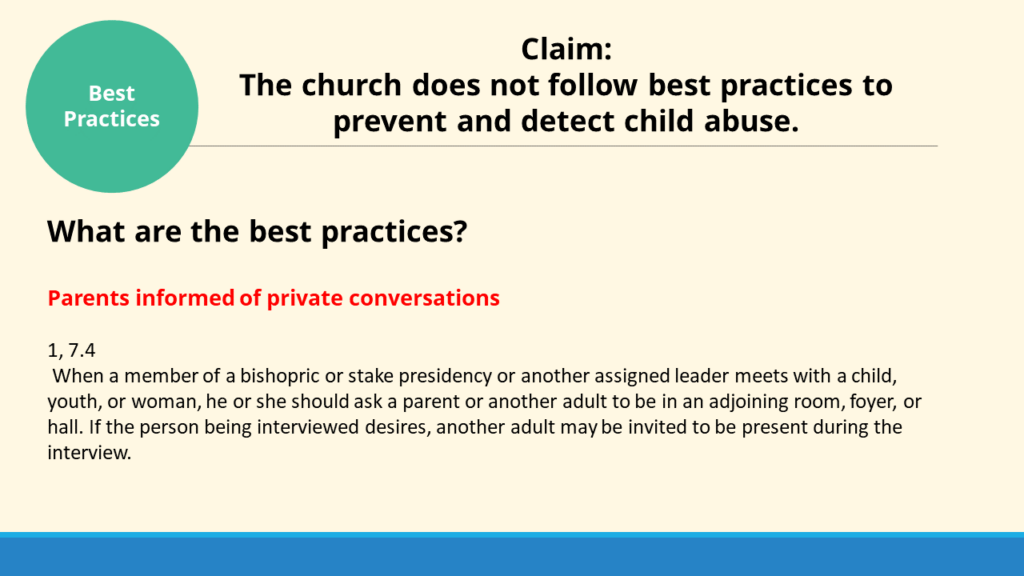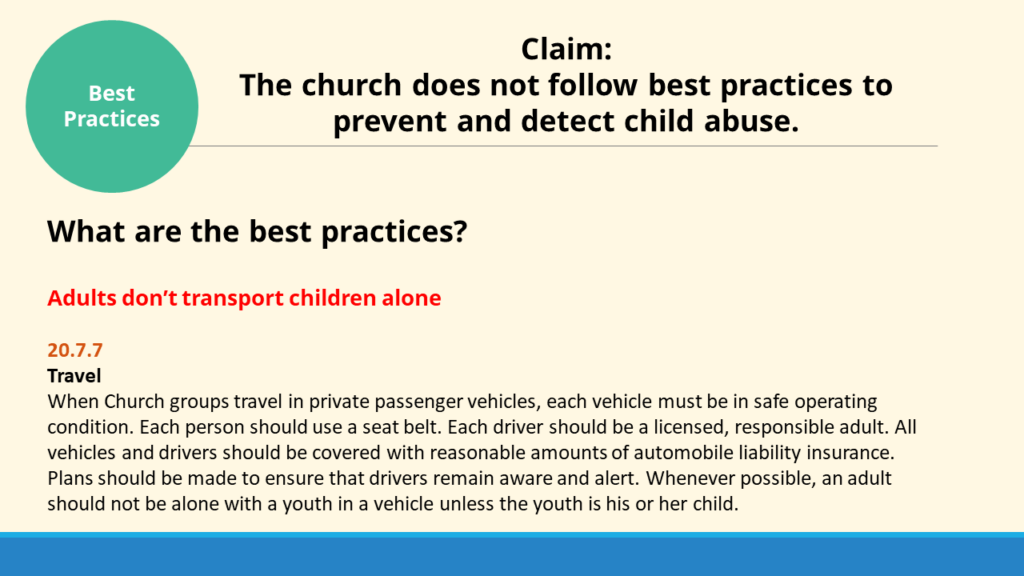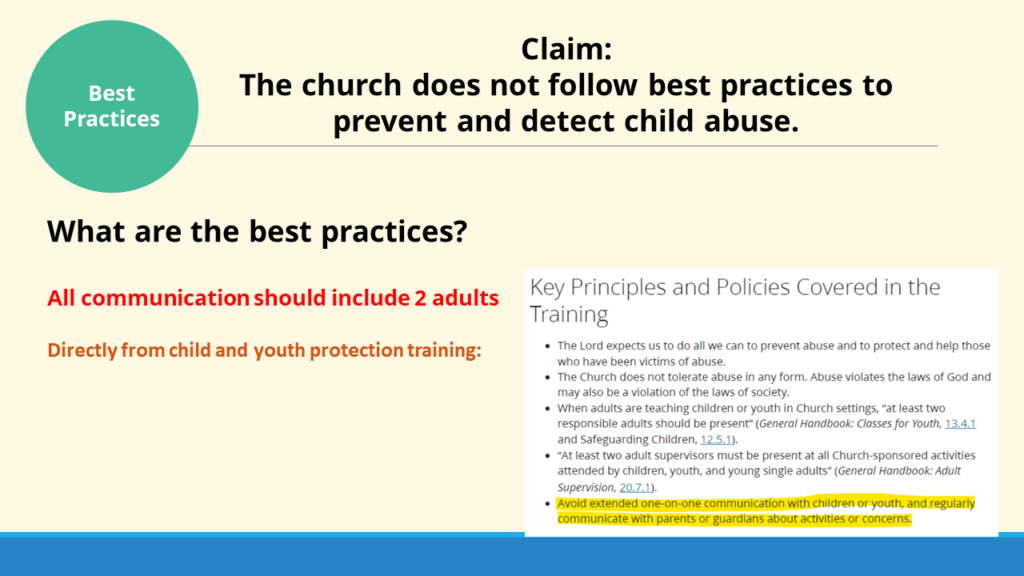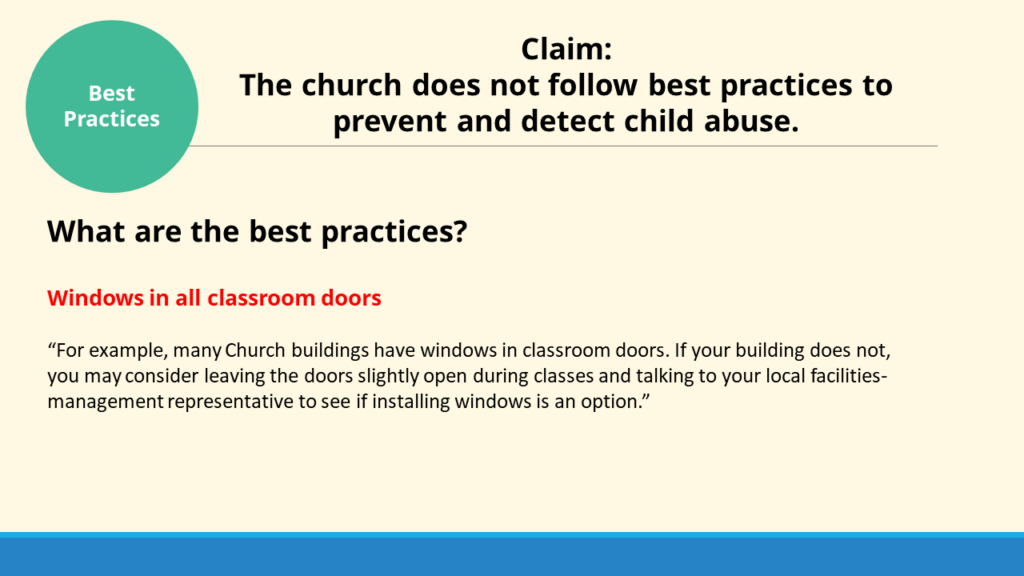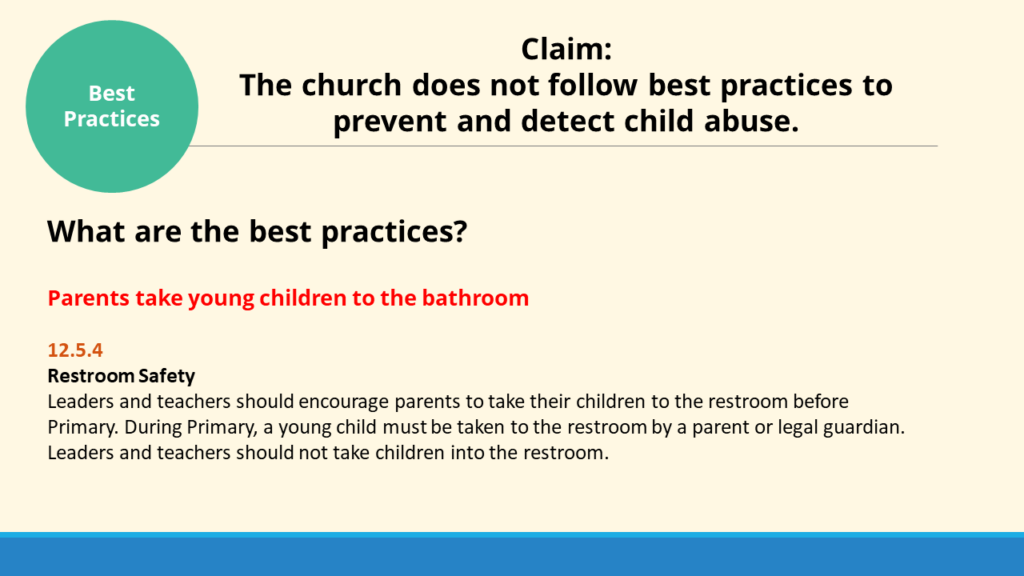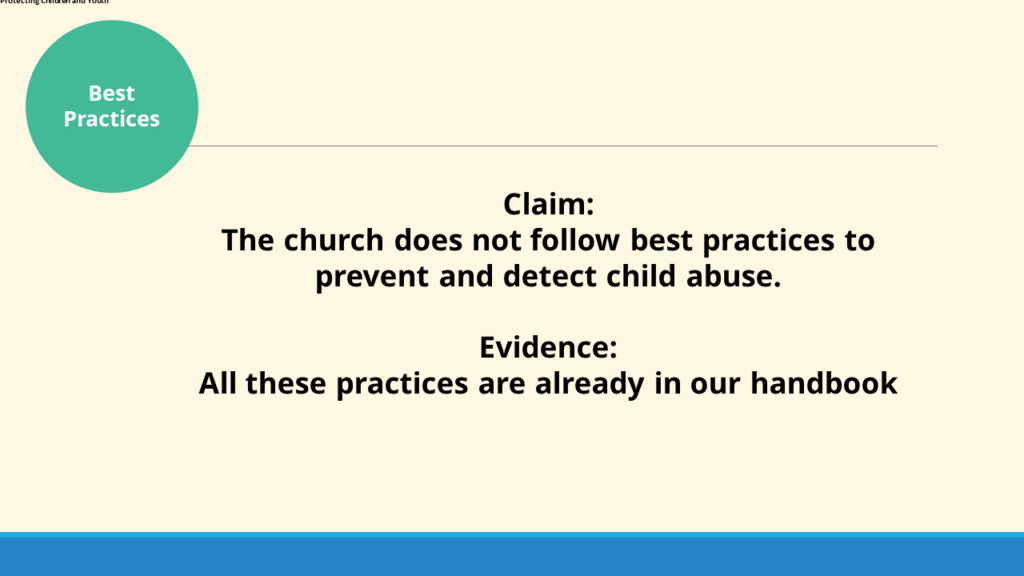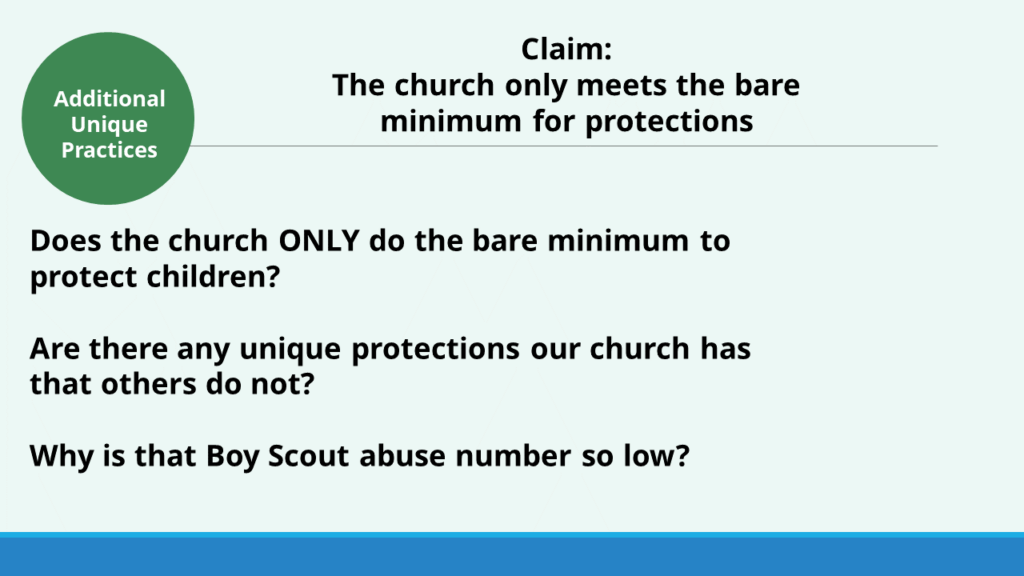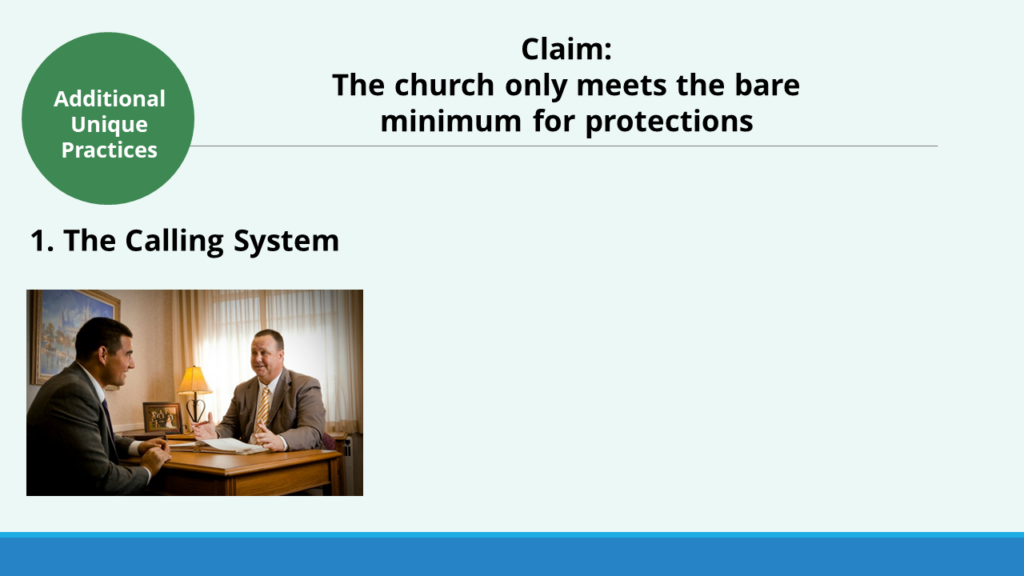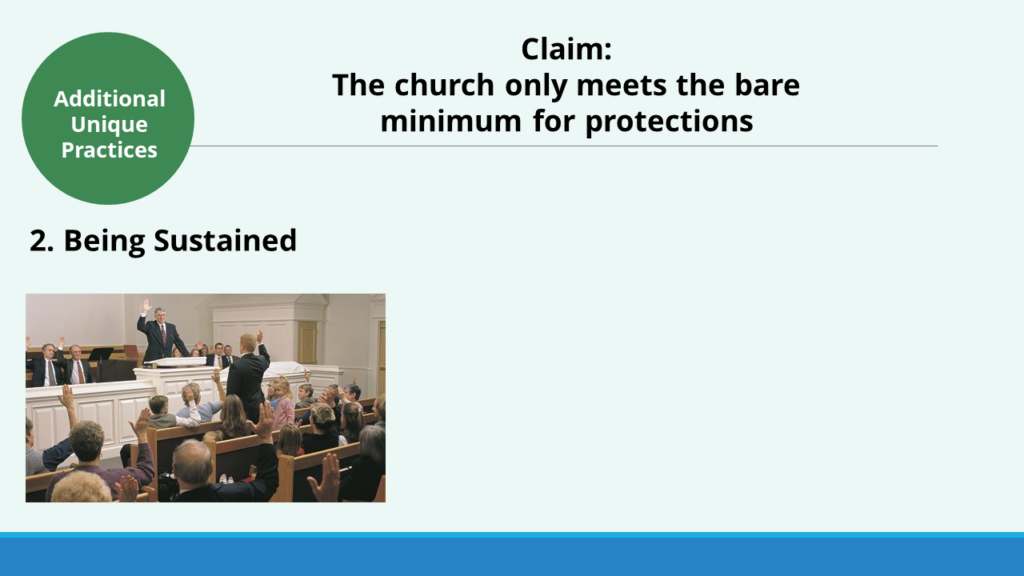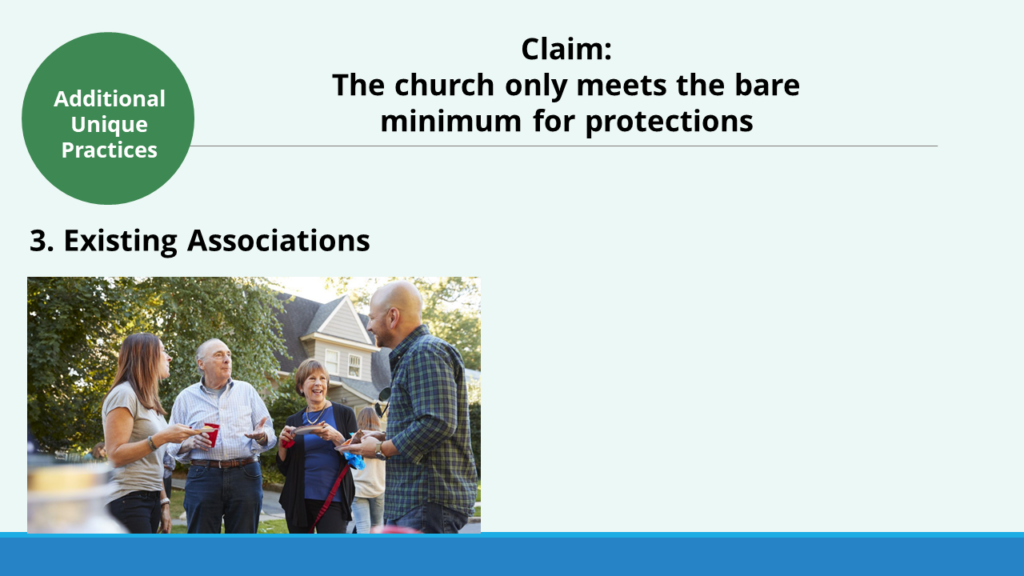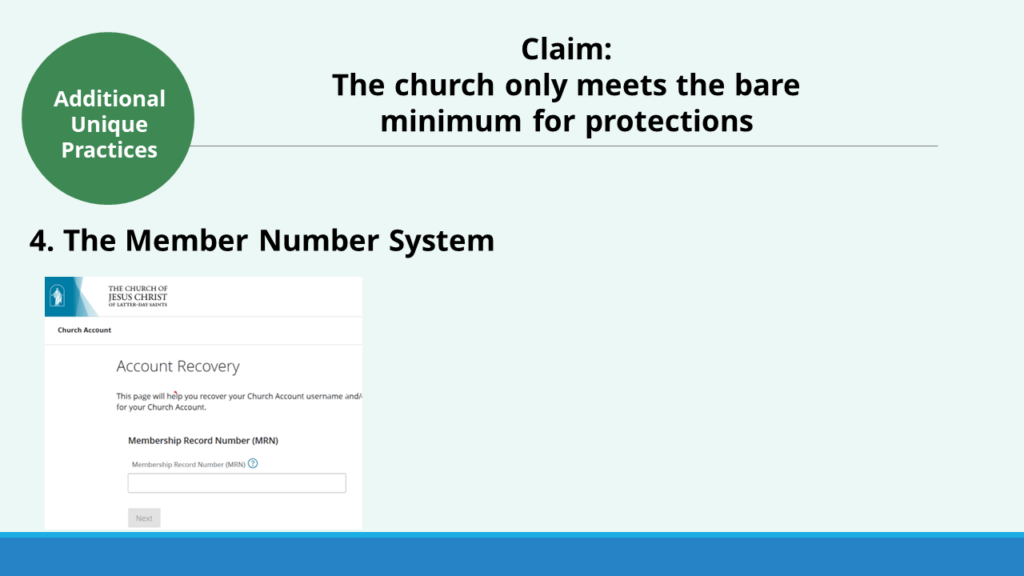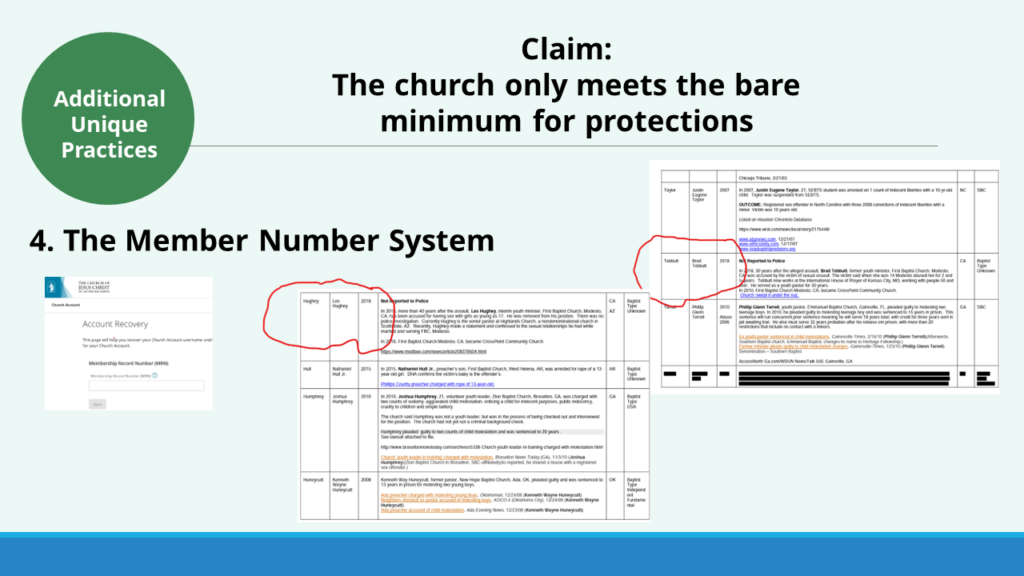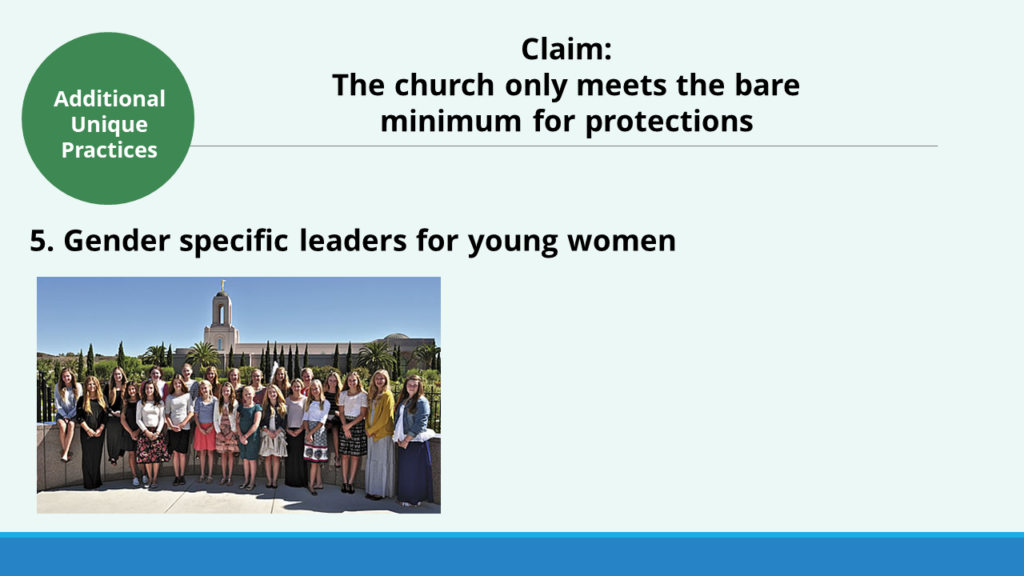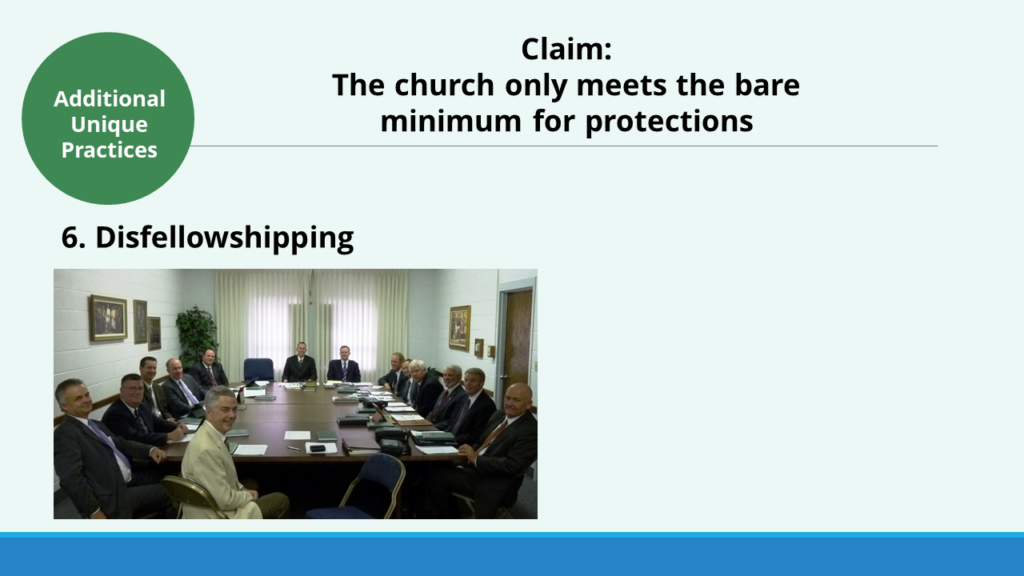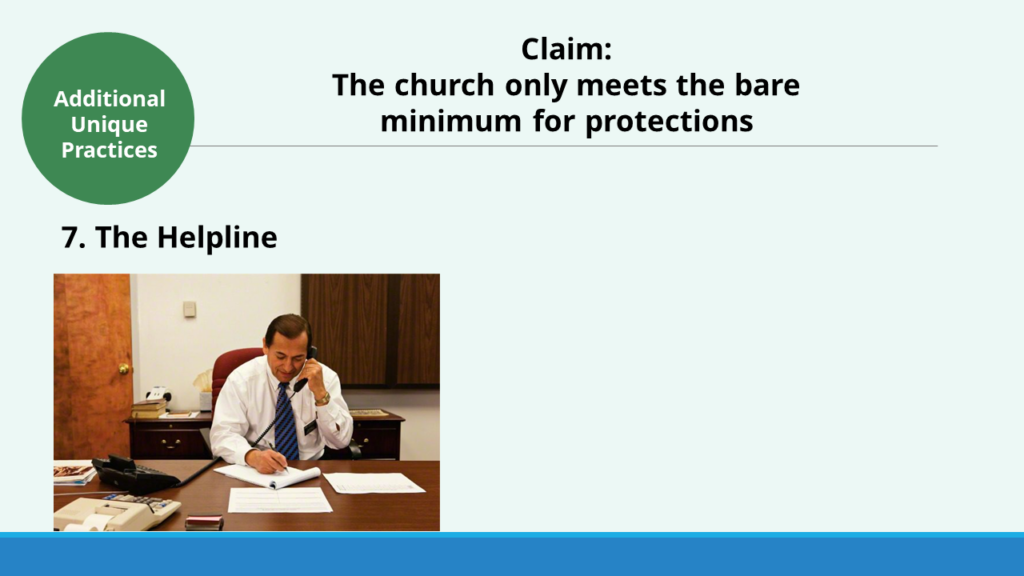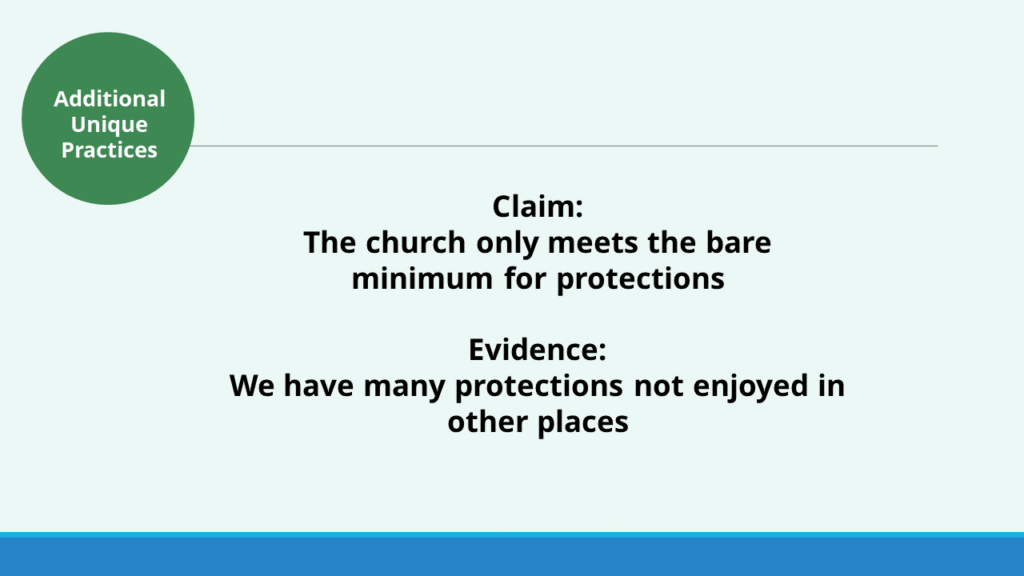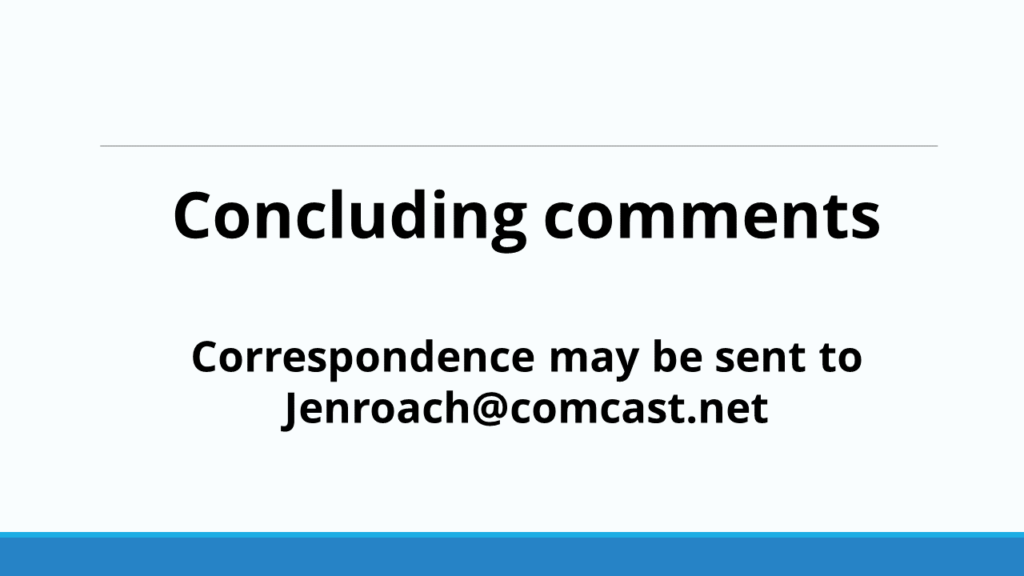
August 2023
Introduction by Scott Gordon
We are pleased to hear from Jennifer Roach. Jennifer Roach holds dual master’s degrees in counseling psychology and theology. She converted to the LDS church four years ago. She has spent most of her life in the Evangelical church. She has had positions of responsibility and authority in the evangelical church that she belonged to. She’s also a poster child, unfortunately, for abuse — as she herself went through those terrible years that I’m sure she would never dream would be a blessing. And yet it’s a blessing for us because she can come and talk to us about that subject with what I would call authenticity, because she knows firsthand what it’s all about. So, with that, I’d like to introduce Jennifer Roach.
Presentation by Jennifer Roach
It is so good to be here at FAIR! I will tell you this: I joined the church four and a half years ago. Five and a half years ago, I was investigating the church. I had some questions that the missionaries couldn’t answer. And the adult members of the church I knew — very smart, intelligent people — and they still had no idea what I was talking about. And that’s how I found FAIR. If you’re not aware of this, FAIR has a service: you can email in questions about anything about our faith, and you’ll get a bunch of really, really thoughtful answers. And so, I had a question about Gnosticism because I’m weird. So, I emailed in some questions and got five or six amazing responses that helped me move on from that issue. I had more after that, but it helped me move on from that one and I probably wouldn’t be in this church without FAIR, so it’s really fun for me to be able to be here with you.
Nobody grows up saying “I want to become an expert on sexual abuse in a church context.”
The talk that I’m giving to you today — you know, I mean, nobody grows up saying “I want to become an expert on sexual abuse in a church context.” But we’ve already managed multiple difficult issues this week here at FAIR: lots of conversations about hard topics. So, I am just going to add on to that pile.
I’m a mental health therapist. I have an office here in Provo. You can ask me things about myself if you want.
This time last year: you might recognize this picture from this article — on the first day of FAIR (I wasn’t living here in Utah at the time) I woke up in my hotel, did what I always do, which is, I like to check the newspapers. And like many of you, I read a horrific story about an LDS family in Bisbee, Arizona, where the father had abused the children. It is a terrible story. But to be honest, I was on my way to the conference. I had a number of friends and colleagues who were speaking, I was excited to hear them — I didn’t really want to spend the time or the emotional energy reading the story. So, I skimmed it and went on with my day. I arrived here. I sat in that back corner, when Josh Coates of the BH Roberts foundation leaned back in his chair and said, “You’re following this Bisbee Arizona case, right?” I said, “Yeah, I saw it. I skimmed it. I didn’t really read it. It’s a horrific case of abuse.” He says “Yeah, it’s a horrific case of abuse. But it’s also a horrific article. It’s deceitful.”
And immediately, I knew what it was that was bothering me so much about this article. One of the difficulties in this article, is that it was written by a reporter that I actually have a great deal of respect for — he exists in the pantheon of great American reporters. And yet he writes this story about our church that I found to be incredibly — not only inaccurate — disingenuous.
So normally, apologetics is a very slow discipline. Right? Most of you in this room know this: we write papers, those papers take a very long time to put together. If we’re lucky, they’re published somewhere. If we’re even more lucky, a year later, a colleague will write a paper in response, and it goes at this pace, right? That’s normal apologetics. Public apologetics or current event apologetics happen fast and furious, and it responds to something in the moment. Once I started to absorb this article and understand what was going on, I realized: the way that this is written, people will take this as gospel truth, and this will damage some people’s faith. And so, it set me out on a quest.
My personal experience with abuse
To answer some questions (and I’m trying to do my notes and my clicker at the same time). I happen to know some things about good tellings of abuse stories and bad tellings. If you have watched my podcast at all you might have seen the episode that’s my conversion story. My conversion story runs right through the middle of abuse in the media stories. My hometown newspaper, the Modesto Bee, ran a story about the church where I grew up (I grew up outside of the LDS church), where one pastor after another abused teenagers in this church — and I was one of them. The paper wrote about this. You can listen to the experience that I had and it’s actually how I ended up here in our church.
I know what it is to read a good telling of abuse in a church, and I know what it’s like to read a disingenuous one and I realized that this was a disingenuous one: however, it’s written very skillfully. Every single word in that AP article about this family in Arizona is chosen specifically for its emotional impact. There’s a video package that goes along with it. Every note of music, every image, every word is chosen for its impact — and it had impact. If you don’t know people who struggled after reading this story, I would be surprised. I certainly know a lot of them.
The six most frequently asked questions
Today what I want to do is talk you through six of the most frequently asked questions that come up when people are talking about sexual abuse in our church. We are going to spend the most time on the first two (I’m most excited about those) but hopefully we will have time to get all six of them. Here they are.
- This is the question that I get asked more than any other question. Why is there so much more abuse in the LDS church than in other churches? I would not be surprised if you’ve gotten that question.
- Why aren’t we requiring universal background checks for every volunteer?
- What is the helpline? And I heard it exists only to hide abuse.
- What are the best practices in preventing and detecting abuse? And does our church follow them?
- Do we have any unique protections for kids in our church? And,
- How can we get better at detecting abuse?
Rates of abuse in the Church of Jesus Christ of Latter-day Saints
So, let’s take number one. Here are my assumptions. Sexual abuse happens in every church. Some practices in some churches discourage abuse, while others allow it to flourish. Abuse can happen anywhere. But it would be really great if we could understand where it’s happening more and where it’s happening less, just to get some data. Because saying ‘abuse can happen anywhere’ — While that’s true — it doesn’t give us a lot of information to know, is what we’re doing working? Isn’t it? Is someone else doing something that we need to be learning from? These questions are important.
I’m going to speak to you in a very forthright and direct way about these things. Don’t mistake that for lack of compassion. Don’t mistake that for not caring about the experience of these victims. I care very much about that. But unless we can speak about these things in direct ways, we have no opportunity whatsoever to understand what’s going on. And certainly, no opportunity to make anything any better.
So, without data, here’s what happens. This is a quote from The Daily Utah Chronicle. It’s the independent student paper at the University of Utah. This is one of the more mild quotes — if you have read about this topic at all, you’ve probably heard quite a bit worse ones. An author says, “I ended up leaving the Catholic church after I watched a priest defend molestation during a sermon, in the name of forgiveness. It was a horrendous sermon to watch. And in Christian communities like the Catholic Church and the Church of Jesus Christ of Latter-Day Saints, it’s a common message.”
Well, people say this — people say quite a bit worse — but is it even true? We have very little data, at least up until now, to check statements like this against.
So, I want to introduce you to the Boy Scout Victim’s Compensation trust.
You might have heard of this. It was in the news back in April, the Boy Scouts exited bankruptcy. Part of that was establishing a fund, to fund settlements for victims. Now. The church gave an awful lot of money to this fund — and we are going to get to that.
The cost of abuse to victims
Before I do, let me say this: sexual abuse costs victims something. If you have the idea in your head, “They’re just money grubbing. They’re just trying to get an easy cash out,” please remove that thought from your head. Victims have a lower lifetime earning potential. Their education is delayed. They face all kinds of mental and physical health problems. They deserve a settlement when abuse has happened. And it falls under the guidelines of this particular trust in this case, or of another one. I know that sometimes the thinking towards, “Oh, they’re a victim, they’re just trying to get an easy dollar.” I know that’s a tempting thing to think. Please try and remove that from your head.
Is the Church responsible for 30% of the abuse that’s happened in the Boy Scouts?
So, the Boy Scouts Victim Compensation Trust: the church paid $250 million into this fund, or 30% of the fund. The question that rises in my mind is: “Huh. How did they come up with that number? How did they come up with that percent? Why 30%?” I mean, it’s an interesting question, right? And you can find claims online where people will say — this is a quote — “They’re getting off for pennies on the dollar. Surely the church is responsible for more than 30% of the abuse that’s happened in the Boy Scouts!” But is that true? Well, is our Church responsible for 30% of the abuse that happened? So, what can we actually know?
Well, we know that depending upon the decade, LDS affiliate affiliated troops made up to 30% of Boy Scout troops. You can see here in this chart the light blue represents the 30% of LDS troops, the slightly darker blue are troops sponsored by some other church, the darkest blue — those are those are troops sponsored by civic organizations: schools, the Highway Patrol, service clubs, things like that. So, we paid in to this fund 30%. We had 30% of the troops. So, here’s those graphs together.
The logical question is, was this the right amount, or wasn’t it?
The Boy Scout Perversion Files – the “P-files”
Well, it turns out there’s actually a way to answer that question with research. We do not have access to all of the information on all of the claims about the Boy Scouts or all of the abuse that has happened. But let me introduce you to the Boy Scout Perversion Files.
Technically their name is “the Boy Scout Ineligible Volunteer Files.” Everyone calls them the “P files”: ‘P’ for ‘perversion.’ And what they are — Over the last 80 years, the Boy Scouts have kept records on the abuse and other perversions (we’ll get to that) that have happened in their ranks. They have documented these for quite a long time. Those documents have been put into a database. The Los Angeles Times owns that database. You can go online — anyone can — you can search it for free. You can see abusers that happened in your area, you can search by their names, you can search by troop number. It’s very fascinating just to kind of look through. I decided to analyze these files and find out what we could learn.
So. The files vary widely in terms of their size and their completeness. Some are just a couple of pages, especially the older ones. The older ones are not very complete, while others have like 100 pages in them or more. Court documents, victim statements, photographs, newspaper clippings, all kinds of things are in there – and, interestingly enough, they all come with this cover sheet, which I think you can see there on the slide. It asks the religion of the person accused of doing the abuse.
Most abusers are men
I say ‘the person’ — it’s mostly men, that’s just what it is. There’s a couple of women in this database. They are statistically insignificant in their numbers and generally that’s the case with abuse. The examples that just popped into your mind that you can think of, of schoolteachers, those are the exceptions, certainly not the rule. So, these files ask the man’s religion. I don’t actually know of any other data set that does this: That compares, that gives us data on a number of churches, we can see their religion, and we know they all committed abuse. If you know of a data set that does anything like this, I want to know about it. My email is at the end of this presentation. Hook me up. I’d like to replicate this research with a different dataset. I don’t know of another one that does what this one does. The cover sheet that you see here lists the man’s religion.
When it is not listed (and sometimes it’s not) it’s not that hard to look through the file and find the affiliation of the troop. There are notes in there that the scout leadership will call the Bishop of whatever LDS ward and talk to the bishop — well, clearly this is an LDS affiliated troop. Or similar for Methodists or Catholics or whatever.
Which information is useful?
Here you see 100 figures and they are going to represent for us all of the abusers found in the P files. There are about 5,000 cases in those files: here we have 100 figures to represent them.
1% of those files are so far redacted that they are just not useful. So those got eliminated from the analysis. There’s just not enough information in them for a variety of reasons.
3% of them, no religion was listed and there was so little information in the file that I could not determine if — was this a Catholic affiliated troop? Who were these people? There just wasn’t enough information. Those files were also eliminated from the analysis.
And, they’re the perversion files not the abuse files: so, the non-abuse perversions, I pulled those out as well. For example, there’s a file of a man in the 1950s. He’s an adult man, he’s having a homosexual relationship with another adult man in a consensual matter outside of the Boy Scouts — clearly that is not childhood sexual abuse. In the 1950s that’s considered perversion, and so they have a file on this man. All the files like that I eliminated. They don’t work for our purposes.
So that leaves us with 95% of the database that’s usable. The 95 black figures you see here represent abusers who we know what church they came from. Right?
So, all of a sudden, our question is starting to get even a little bit more interesting. Are 30% of these leaders LDS? This is the group that committed abuse in the boy scouts. 30% of the troops were LDS; we gave 30% to this Victims Compensation Fund. Is that the right number, or isn’t it?
75% less abuse in LDS troops
Using statistical sampling I pulled files to see who’s committing this abuse. What was their troop affiliation? Remember, here’s our 30%.
So, what was it?
It wasn’t even close! Not even close to 30%. 5.16% of the abusers were LDS affiliated.
Now that is not something to get so excited about. ‘Yay, only 5% were abusing.’ It’s still a terrible number, the number should still be zero. However, 5.16%: statistically, that means we’re seeing 75% less abuse in an LDS troop than in a non-LDS troop.
If you had your choice of a troop to put your kid in, which one do you put them in? The one that’s got a 75% less chance or the one that doesn’t? I mean, I know where I would put my kid.
Statistical results
I haven’t been in graduate school for a long time. So, I was a little shaky on my statistical methods. I called up a friend who is a statistician expert and said, “You’ve got to look at my numbers. You’ve got to make sure I’m doing this right. And you’ve got to tell me, are these valid numbers?” and he says, “I got you: we’re going to do a test.” If you’re familiar with statistics at all, we have a test — we generate a ‘p value.’ A P value tells you what’s the likelihood that the result you got happened by chance with nothing behind it driving it. We just got lucky and only had 5% of abuse. What’s the chance of that? Well, well, there’s the number. It’s a 10 quintillionth of a chance that that’s what happened here. I didn’t even know 10 quintillion was a number. A 10 quintillionth is zero chance. Something is driving our lower numbers — and yet we have this reputation of, “oh, it’s the Catholics and it’s the Church of Jesus Christ of Latter-Day Saints.” The numbers do not support that.
Less abuse in LDS Church is statistically provable
The claim is that there has been more sexual abuse in the LDS church than in other churches. The evidence says there’s actually statistically, provably less abuse — at least in this dataset, At least when we’re looking at these numbers. I don’t know how to get access to other numbers to look at them. If you do, please tell me — but the one dataset that we have access to, it’s significantly less.
The issues with background checks
We’re going to take up the next question, which the claim is “if the church really wanted to protect kids, we would require universal background checks.” You might have heard recently in the news, the saints in England had kind of a grass-roots movement to require the church to do background checks. I love their activism. I love their hearts for this.
But do background checks work? Do you even know what a background check is? Do you know what it’s checking? I think most people do not.
There are three issues with background checks. One has to do with delayed disclosure; two, the statute of limitations; and three is there are almost no convictions for childhood sexual abuse. That’s just the sad reality. So, do background checks work?
Delayed disclosure
I want you to imagine for a minute that you experienced childhood sexual abuse. You’re an adult now. At what age do you think you would first start talking about that abuse? During childhood? Age eighteen? Age 25? Age 45? Do you have your number in your mind?
It’s 52. 52 years old is the average first age that people start talking about this. This statistic comes from the group ChildUSA and they have quite good research to back this up.
This is their chart — you can see on the left there, the first bar on the graph, that is childhood abuse detected in childhood. Now you will notice I say ‘detected’ not ‘disclosed.’ We will get to that in a bit. Abuse happening in childhood is much, much, much more likely to be detected not disclosed, in part because adults don’t know how to listen to what children are saying when they’re trying to disclose and most of the time, we miss it. The next bar is the 20s and 30s. The bar after that is the 40s and 50s. Almost no one discloses then, not for the first time. That largest graph there the largest bar on the graph, the orange — that’s age 50 to 70: first disclosure.
Statute of limitations
Why am I telling you all of this? We have a statute of limitations issue to work with. Now. Criminal statutes of limitations are different than civil statutes of limitations, and various levels of different crimes have different levels. So, I cannot possibly produce a chart that shows you all of that in one chart. This list is the statute of limitations for criminal sexual abuse in these states. You’ll see there, the oldest one is age 40. If you live in California, you have until age 40 to disclose your childhood sexual abuse. If you live in Florida, you’ve got till age 21. Now 40 is better than 21 but it’s still a long way from 52.
So, you run up against this problem. There we are — disclosure between ages 50 and 70. California is a rather generous state to do it at 40. But look how many people disclose before they’re 40: almost no one.
You can see the problem here, right? If someone abuses a 12-year-old girl today, she is going to wait four decades – on average – before she talks about it. That means no charges are going to be filed. That means no charges are going to be found on a background check. Because almost no one reports within the statute of limitations: no charges, nothing to find. Clean, clean, background check. Most abusers get away with abuse for this reason.
Now here’s a chart: on the left-hand side are the worst states. That tallest one, you have to report before age 34 in those states. All the way on the right are the best ones, they have no limit on at least some types of reporting. The column down from that, Utah is in that column. We actually have some pretty good laws around that here in Utah. But it varies widely depending upon where you live — like I was saying, in Florida: 21? You don’t know anything. You don’t know anything at 21. Right? Nope, nobody’s disclosing their abuse at that age.
What even is a background check?
So, what even is a background check? Without this reporting gap problem, we still have a big problem with background checks. I want you to think for a minute: what do you believe is actually being checked in a background check? We say that word all the time. I asked some friends, “Tell me what you think. What do you think is being checked in a background check?”
And here’s what they told me: prior employment history, disciplinary actions at work or on their professional license, their education history, their driving history, their arrest record, their criminal history, their involvement in lawsuits, including bankruptcy and family law, checks on aliases, Family and Medical History, personal debt, personal references, credit score, their social security number, checking the sex offender website, their address history, a social media review (including a review of comments they have left on things), their marriages and divorces, their child protection, their CPS history, their group affiliations, and their arrests (not just their convictions). This is what a lot of people think a background check is.
Here’s what a background check actually is.
You can see the items there in red. They’re going to check a criminal history for the past seven years. Better than nothing…I guess? We’ll get to that. But seven years isn’t very long, especially once you understand not only the delayed disclosure, but the statute of limitations problem. I don’t have time to go into it, but you should be making the connection about how and why most abusers get away with it and are never going to be caught by the law or in a background check. Background checks also include a check on their aliases, it’ll verify their social security number, their date of birth. The publicly available sex offender websites will be checked, their address history is checked. Their name. Many of these companies that do background checks, they check and see if the person is on the terrorist watch list. I don’t quite understand the logic of that one. But that’s one of the things they check.
Having a clear background check — what that actually means is: the person gave their correct name, date of birth, social security number and address. They are not on the terrorist watch list. They haven’t been convicted of a crime in the last seven years. They’re not on the sex offender website. (Though a very small percentage are.) All this to say… how do we really want to be thinking about background checks? Here’s the thing: you can trust a background check that has something show up on it. If it says, “so and so committed this abuse against a child two years ago” – that’s not a false positive. That’s true.
However, if someone has a “clean” background check, you have no idea. You have absolutely no idea if that person has committed abuse or if they haven’t. And here’s where it gets scary for parents and for church leaders. If we require background checks and someone’s check comes back clean, we’re going to tell that to parents, “Brother so-and-so has a clean background check.” That endears a lot more trust in parents than saying something like, “Nothing was found on his record.” But “nothing was found on his record” is at least honest. Calling them ‘background checks’ is over-promising something that you can’t even possibly begin to check. And it gives false confidence to parents that they should trust someone that you actually have no idea if they should trust.
The question here is, “Well, it’s better than nothing right?” Mmmm…probably? More and more states are going to start requiring them. Soon it’ll probably be required everywhere. It’ll be a normal thing that we have to do. I’m not against background checks, but I am against the way that we talk about them. And if they become required in your area, you need to know what a background check is, what it’s checking, what it’s not checking, and what the results actually say and mean.
I’ll just drive home the point for you and I’m sorry to do it in this way. The man from that Bisby Arizona case: he’s the worst abuser I’ve ever read about in my life, and I’m a therapist. If you don’t know the details of that case, I’m kind of jealous of you because they’re horrific. That man, his name is Paul Adams, he could pass a background check until the day he hung himself in jail. He was a border patrol agent. He passed a federal level background check every single year. A federal level background check is much closer to what people imagine a background check is in the first place. He passed it with flying colors, no problem. And he’s one of the most horrific abusers I’ve ever heard of.
So, the claim, “If the church really wanted to keep kids safe from abuse, they would require background checks.” Here’s my evidence. We must do a better job educating people that “he has a clean background check” is identical to “we didn’t find anything on his record,” because it’s going to clue parents in differently about their responsibility of still watching over their own children.
The helpline
Next, we’re going to talk about the helpline. You are probably familiar with it — at least this crowd probably is — so I’m not going to spend too much time explaining to you what it is. It was developed in 1995 so that church leaders around the world could have assistance in helping the emotional/spiritual care of victims as well as fulfill their legal responsibilities in the various geographic areas.
Accusation: The helpline exists to hide abuse
The current accusation is that the helpline exists just to get the church out of legal trouble: it exists to hide abuse. This accusation is upsetting to many, many people, including people who are faithful members of this church. And I understand why! That’s a vile claim — that our church would have institutionalized something to protect our own reputation at the expense of children. The accusation is vile. But is it true?
I’m going to address the Arizona case first before I get to that, just because I brought it up and I need to close that loop for you. The case involves two bishops. The accusation is both bishops knew about this abuse actively going on. They sat home, warm in their houses, with their hands in their laps, knowing abuse was going on, and had been instructed to hide it by the helpline. That’s the accusation. Both bishops, Bishop One and Bishop Two, both declare in court: They didn’t know. They knew of a one-time incident.
Before you let your mind run away with what that even means — you don’t know. I don’t know. These two bishops have never, ever betrayed their duty as bishops to hold confidential what they’re required to hold confidential. You don’t know the details of what that one-time incident was, and I don’t either. But both of them have declared in court that they found out the same way that you and I did — in the newspaper. They were not sitting at home, knowing children were being abused, and just letting it happen.
These are, the quotes that are there, those are just snippets from the publicly available documents that you can get on the court website for this case.
What we know: both bishops knew of past one-time event, the details were not specified. And both bishops say that they found out the same way you did. So, the AP story is telling a narrative that just isn’t true.
Back to the helpline. So, the accusation is that the helpline is there just to keep the church out of legal trouble. It’s a weird claim, made in the context of this Arizona case, Paul Adams, the abuser — he was not a leader in our church, of any kind. He barely attended. He’d only ever received the Aaronic priesthood. He had not been endowed. He didn’t hold a calling. He was no leader whatsoever in our church. Quite frankly, if the church was trying to protect our reputation, it would have just hung that guy out to dry, right? They’d gain nothing from protecting a man like that. So, the claim that the helpline told the bishops, “Oh, you must protect our reputation. You must protect the reputation of this man who comes twice a year.” It’s laughable.
Why do we need a helpline?
I want you to pretend for a minute that you are a bishop in the state of Utah. (Kind of easy for some of you, I know.) In the course of your normal Bishop duties, you learn about two scenarios.
- Two 13-year-olds have engaged in sexual touching with each other; and
- A 16-year-old and a 22-year-old have had sexual intercourse.
Think in your mind for a minute. Which one of those is a crime?
You’re the bishop you do some research. You learn that the age of consent in Utah is 18. Does that make both of these crimes? The one of them they were both 13-year-olds, does that mean neither of these (are crimes)? What in the world?
Well, I’m not a lawyer, but I can look up the criminal code online just as well as you can. Let me share with you two things that are in the Utah State Criminal Code currently today. Section 76-5-401.3 says no one may engage in sexual touching with a 13-year-old — not even another 13-year-old — and it was a crime if it happens. The section right before that 76-5-401.2 says it is legal for an adult who is less than 7 years older than a 16-year-old or 17-year-old to have sexual intercourse with them as long as it’s consensual. An adult “commits unlawful sexual conduct with a 16- or 17- year-old minor if the actor is seven or more years older, but less than 10 (it becomes a different category of crime after that).”
So, wait a minute, the age of consent is 18. But here maybe it’s 16 and it’s certainly not 13. But if it’s another 13-year-old, it’s still a crime.
The two 13-year-olds engaging in sexual touching is the crime here. The 16-year-old and the 22 year old is actually not a crime. It’s allowed for in the current Utah statutes. Would you have known that off the top of your head if you’re a bishop? Is either one of these abuse? Does it need to be reported? Are you harboring a sexual predator if you don’t report it? Do you see why we need a helpline? Because that confused me.
So the claim “the helpline is there to keep the church out of legal trouble,” here’s my evidence — of course it is! Do you know what the best way to stay out of legal trouble is? Follow the law! So yeah, the abuse helpline is there to help people do that. It’s also there to help care for victims. But you bet it’s there to keep the church out of legal trouble and it’s doing that by explaining to people (like you and me who are not lawyers) “Here’s what you need to do.”
Best practices
We’re going to go through this one super quick because I’m almost out of time (as every other speaker has said this week). Best practices, here they are: screening of volunteers, training of volunteers, abuse is properly reported, two-deep rule (that means two adults at a time anytime there are children or teens around), parents informed of private conversations and given a chance to join when possible, adults do not transport children alone. All communication should include two adults, windows in all classroom doors, and parents are taking the youngest children to the bathroom. I don’t have time to go through all of these; I went through and pulled out — these are all listed in our handbook. This is nothing new. If you have taken the church’s training for youth and children you know all of these. We very, very easily follow these best practices. So the question that is quite a bit more interesting. (Hang on, I gotta scroll it to where my notes are because I have to scroll past all of these that I was going to tell you about in detail. I think you can see my notes later when you see this presentation).
What is the Church’s standard for protecting children from abuse?
The more interesting question is: are we doing anything that’s above this gold standard, which actually ironically, has sort of become the bare minimum — everybody does those things. All the things on that list? Every church does those, everybody cares about stopping sexual abuse. We’re not something special because we do those things. And, and those things are not what’s driving a number like that 5.16% to be so low, because if they were everybody would be having a low number like that and they don’t — so what are we doing that’s different?
Some of these, you might laugh — and I’m okay with that — because you will not recognize them as protections that our church has for children, but they are. Number one is the calling system.
The calling system
Leaders in our church are chosen and called (compared to other churches where they raise their hand and volunteer). Now, I know, I know very well, that this system is not always followed. And if you walked into your ward today and said to your exhausted bishop, “Hey, I’d like to volunteer for activity days,” he might be tempted to call you on the spot. However, when the system is followed properly, this system is a protection because it allows for this careful consideration of “who are these leaders going to be?” In other churches, you can walk in the door on one Sunday, volunteer to work with children. Some of them have requirements, hoops you have to jump through, but within one to six months you can be sitting in a classroom and have a child put on your lap, simply because you volunteered. Now, if you’re an abuser, what church are you going to choose to go to? One where you can walk in and volunteer within six months, or one where you have to sit around and wait and see if you’re going to get called or not.
Being sustained
Being sustained. That to me this is the most hysterical one because we do this just — you know, like, every Sunday we sustain all the new callings, right? And we never think of this as a child protection. Let me tell you why it is. In a lot of churches, someone could volunteer to work with children and the rest of the congregation would never know. But if a guy over here volunteers, and a person over here actually has some information about some of the sketchy things they’ve done with children, in our church — maybe that person doesn’t have the confidence to raise their hand and object in the middle of sacrament meeting, but they know they can go talk to the bishop about it. And in most other churches, if you don’t have a kid, you don’t know who volunteers with the kids. So, if you have information about them you, don’t even know that you should be giving it.
Existing associations
Existing associations. This has to do with the fact that our wards are organized by boundaries. Now, this works way better in a place here like in Utah. My ward is all high-density housing and my entire ward fits in three blocks. I can see the building everyone lives in from my window, right? In lots of places, I know that a ward boundary — you have to drive three hours to get across it. So, this doesn’t work everywhere. However, in other churches, people can drive as far as they want to go to church. You want to drive an hour away from where you live? Where no one knows you? Where there are no parents that you’ve ever made feel uncomfortable for how you are around their children? You can do it. And then when things go bad at that one, you just go to another one — and no one will ever know. You get a clean slate every single time.
Because we are instructed to attend within our geographic boundaries — it’s not a perfect protection. That’s not a perfect protection in a ward boundary that’s three hours across. It’s better in one that’s three blocks across, but I bet yours isn’t that. It’s still better than knowing, “Oh yeah, this guy comes to our church, but he lives two hours away. Why is he driving two hours away to come to this church?” So, existing associations.
The member number system
The member number system — this naturally leads right into this– bishops can make an annotation by persons member number that follows them. If this person decides, “I’m going to leave overly populated LDS Utah and go move somewhere else in the world,” that number moves with them — including an annotation that their bishop may have made on their record about their behavior, or accusations or convictions around children — to alert the leaders who are going to receive them in their new Ward.
I’m gonna tell you this because I just really want to, about 10 years ago, the Southern Baptists were being pressured by a group of advocates to create a member number system exactly for this reason, so that abusers could be tracked, and they refused. They said, “We have 14 million members. There’s no way we could track all of them.” And then what they did was they started keeping a “secret list” of those abusers, and they kept it at their headquarters, and they didn’t tell the local leaders and they knew exactly who those abusers were. Seen here on this slide, the two red circles. Those are two pastors of the church I grew up in. They’re on the Southern Baptist list. Right? Your member number — I know you don’t think of that as a child protection, but it absolutely is.
Gender-specific leaders for young women
I’ll just spend a second on this. We have gender specific leaders for young women. A lot of places this does not happen. I’m sorry, but men commit more abuse than women do. Teenage girls are abused more frequently than teenage boys are. Our girls are safer having assigned leaders looking out for them.
Disfellowshipping
If you don’t know someone who has a testimony of disfellowshipping in our church, I’m happy to meet you because I do. If you are caught abusing kids in our church, you will be kicked out, and it requires First Presidency approval for you to come back. The pastor who abused me — he’s still a pastor. He still works at a church. I know where it is. They pay him. They know the whole story. It was in the newspaper. They don’t care. “Forgive! We have to forgive him. He’s moved on.” That’s how it’s normally dealt with. In our church, they’ll kick you out over it.
The helpline
The helpline is a protection despite what people will tell you. My own Bishop, he’s a wonderful man. He’s a mechanic. He can fix anything with an engine. But my guess is the day he became a bishop, he was not like downloaded with all of the perfect information for how to help and support victims. But there’s one phone number he calls, and you can get hooked up with all the resources, exactly what the victim might need. Other places do not have that.
So the claim that we only meet the minimum protections is ridiculous. We have protections not enjoyed in other places. I know that most people don’t think of these as protections, but they absolutely are. This is my theory on why that 5.6% number is what it is.
Conclusion
Concluding comments: This story, especially about Bisbee Arizona, was awful. It was terrible, but do not believe — Oh, I feel emotional over this. Do not believe for one minute that our church is harboring abusers, that we don’t care about that, that we have this secret helpline to help our leaders and members get away with it. That is not the fact. I’ve spent practically every single day of the last year digging into this and that is not the case. I can promise you that. I’d be happy to correspond with you more if you would like more information on that. Here’s my email. If you know of any other sources that are similar to the Boy Scout sources, I would love to hear from you as well. 25 seconds to spare. I’d love to take your questions!
Q&A with Jennifer Roach
Scott Gordon
So, first question. How do you feel about protecting the clergy member confidentiality privilege?
Jennifer Roach
I didn’t address that in my talk. It’s a really complicated issue. The question is essentially, if someone confesses abuse to a clergy member, should they be required to go directly to the police and report that crime. I have really mixed feelings because part of me wants to say “yes, let’s do it.” Like, let’s make sure that this abuser is put away. And you’ve got to think through it. Because if an abuser knows that “if I go and talk to my bishop about this his next call is to 911” — he’s not confessing anything. And at least if you confess to the bishop, that bishop has a chance for some influence in that situation. Whereas if the abuser knows he’s going to report it straight away, bishop has absolutely zero chance for influence. That’s a complicated answer, but that’s where I’m at.
Scott Gordon
No, I like your answer. I don’t usually partake on the other side of the questions, but I personally know a situation where an abuser confessed because he didn’t think it was going to be further disclosed. And because it was confessed, they were able to get people out of dangerous situations, and they were able to use other influences to bring it to light. So… but it is complicated. How can we as members best show support and love to victims of sexual abuse?
Jennifer Roach
Yeah, let me let me talk for a minute about how adults can listen to children in a different way. I gave a FAIR talk back in 2020 on youth Bishop interviews and a lot of this information is in that talk. So, if this is interesting to you go back and listen to that talk. Children and teenagers do not report like an adult would report. We adults, we talk to each other in very direct ways. If you have something to say to your bishop, you set an appointment with him. You show up on time, you sit on his couch, and you say the thing, right? Children don’t do that. Children are weird. You know, they’re weird and they say things — often the way that childhood abuse is detected in childhood, is the kid says something on accident. And an adult who knows what they’re listening for, picks up on it. And what you want to be listening for is stuff that doesn’t sound right. For example, if a kid says something about “Oh yeah, and my uncle was in my bed and then this happened, and then the dog went crazy.” The wise adult needs to circle back. “Your uncle was in your bed? Doesn’t he have a bed?” Ask some follow up questions. That kid is never going to say “hey, look, I need to inform you that sexual abuse is happening to me, and he’s my uncle and here’s exactly…” you are never going to hear that from a kid. So, listening to how kids and teenagers actually report, that’s one of the best supports you can give them.
Scott Gordon
Thank you. So how can parents create an atmosphere for children to talk about anything and everything?
Jennifer Roach
I’ll tell you a quick story. There’s a private school – I used to live in Seattle – a private school near there. They spent an incredible amount of money, bringing in some people to do training for the kids on sexual abuse and what it is and how to how to recognize it, how to report it — all these things. The following week, three 7th grade girls made an appointment with the principal, extraordinary girls because I just told you this doesn’t happen. They sat down with the principal and said, “such and such teacher — he hasn’t done anything. But he makes all of us feel so weird. And we don’t feel safe. We’re kind of worried.” And the principal said to them, “you stop being little detectives. You’re going to ruin someone’s life doing that, knock it off.” Right? Having an atmosphere of taking what your kids say seriously — and I get it, that has consequences. Maybe those girls are wrong. Maybe they’re endangering the career of some teacher, but the kids deserve to at least have it looked at, to at least be taken seriously and not told, “Oh, no, no, you don’t know what you’re talking about.”
Scott Gordon
So, we have one critic who’s been prominent for arguing that bishop should never be alone with a youth. How do you feel about that?
Jennifer Roach
Yeah, reference back to my 2020 FAIR talk, it is all about Bishop interviews. Honestly, I did not include this in this talk, just because I covered it so much back then. There are very, very few places where teenagers get to say something in private to an adult who might know what to do. If I would have had a bishop interview when I was 16 years old, my life would have turned out really different. A bishop interview is an opportunity for a kid to disclose. I mean, I know the claim — the claim is that even asking teenagers about chastity — that in and of itself is abuse. It’s not. That’s not abuse, but it does give you a chance to listen to what a kid has to say. And maybe ferret out if something weird is going on.
Scott Gordon
This one’s a little more complicated, so I’m just going to read it. So, “Jennifer, great presentation. Is there any challenges with the perversion files dataset given that it does not include the cases in which a church member is accused of abusing a young woman, which are outside of the scouting program? Is there any evidence to assume that the statistics would be similar for the perversion files as they would in datasets that include gentleman in the church?”
Jennifer Roach
I mean, it’s a great question. Right? And we don’t know. They’re — the research question of “how do you figure out who has committed what abuse, what abuse happens” — that has vexed researchers, for as long as research has existed, like it’s just not something that we have great data on. So, we have to work with what we have to work with. And right now, that’s the P files. I don’t know what else to say about that one.
Scott Gordon
So, is there a place where I can read more about your research? Probably not yet.
Jennifer Roach
On the FAIR website! There’s a lovely page that’s still in development, of questions and answers. This information is there, and more is coming. Questions of all kinds of things that come up with abuse. If you have a specific question, please email me. I would love to be able to include it on that q&a site.
Scott Gordon
If you go to the fair website and you click on current events, there’s a whole section on abuse that Jennifer’s put together, and it’s really well done and researched and such and is very, very helpful. So, I strongly recommend that. This one says “perpetrators we know personally were abused as children. How does this work into the equation?”
Jennifer Roach
Yeah, I mean, that used to get said a lot, like “people who were abused grow up to abuse.” I actually remember when I was about 20 years old, I was applying for a job at a childcare, like a daycare facility. And one of the questions on the application was, “were you ever abused as a child?” I knew exactly what they were asking. And I lied, and said no, because I didn’t want to be suspected of “Oh, you were abused. I bet you’re going to be an abuser.” That isn’t really — at least in therapy and psychology — that isn’t really how we talk about it anymore. Yes, people with trauma in their backgrounds can grow up to become abusers; people with perfectly normal childhoods can grow up to become abusers. I don’t know — give victims a break and don’t assume that they are going to be abusing people would be what I would say.
Scott Gordon
Okay, this is your last and final question. You’ll enjoy this question. “How do you feel about being everyone’s favorite person ever?”
Jennifer Roach
All I will say about that is I have been in this church for four and a half years and I absolutely love it so much. I wish I had found this church 40 years ago. It’s the best thing in my life that I made this decision. It cost me an incredible amount personally. And I am so, so, so glad to be here.
Scott Gordon
Thank you very much.
Investigate Further
- Mormon child abuse article by the AP | with Jennifer Roach
- Reporting Abuse, Church Helpline, & the Bishop
- Abuse and The Church of Jesus Christ of Latter-day Saints
- Responding to Abuse
- Life Help – Abuse
- What should I do if I know or suspect that someone is being abused?
- “How the Church Approaches Abuse,” Newsroom
- Abuse – Gospel Topics
- Help for Victims
- Protecting Members and Reporting Abuse
- Recognizing Types of Abuse and Abusive Behavior
- Preventing and Responding to Abuse: Instruction Outline
- Recognizing Patterns of Abuse
- Healing the Tragic Scars of Abuse – Elder Richard G. Scott
- He is Risen with Healing in His Wings: We Can be More Than Conquerors – Elder Patrick Kearon
